
Indian religions, also termed as Dharmic faiths or religions, are the religions that originated in the Indian subcontinent; namely Hinduism, Jainism, Buddhism and Sikhism. Of those, this page focuses on buddhism and Hinduism.
While they have similar cosmologies, buddhism and hinduism do have a lot of differences. Not only that,
but the concept of hinduism as a distinct religion is a modern one.
The different denomionations did not consider themselves to be the
same religion before modern day. Their similarities mainly being in
being those groups who accepted the authority of the vedas, and the
existence of brahman. Other dharmic religions may have some of the same gods, but would have been considered semi distinct. Buddhism on the other hand does have many versions, but they are more closely related, stemming from specific traditions branching off.
General info
While the games also have a decent amount of hinduism, buddhism is more central to them, specifically that of mystical vajrayana buddhism. Vajrayana is known as the more mystically focused aspect of buddhism, and the games have it pervade the entire world system, being referenced by all the sides in a similar vein as kabbalah.
Note that although in game buddhist elements tends to be depicted more for chaos, and a little for neutral, there are exceptions to this. For instance, Hugo in IV is designed to look like a buddhist monk and is shaved like them, despite being a Messian. And in nocturne, all the sides, including shijima which is the law analogue have a slight buddhist aesthetic. Law, while not having overt buddhist things has a lot of aesthetics and figures that reference it indirectly.
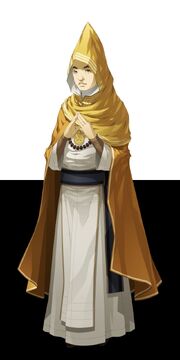
However, there is a strong slant between buddhism and chaos in the games. in I the chaos side uses buddha statues as religious symbols, (also buddhist tantric oms) and has buddhist monks as units. In II virochana and several other buddhist gods are chaos figures. In SJ mem aleph is obviously meant to look like a buddha in the paranirvana pose. In IV the gaians in their temple obviously still look like buddhist monks. In imagine you can see gaians looking like fuke zen monks. And maitreya becomes the leader of the gaians in iva, having an implied chaotic slant.
So this leaning is series-wide. Note how hinduism is more split than buddhism is, with vishnu / krishna being an explicit law character in SMTI. Even though dharmic faiths seem to be a heavy basis for chaos in general. Neutral has a little buddhism also however, with the diamond realm, and en no ozuno being depicted as an incarnation of a bodhissatva.
There seem to be a few reasons for this association between chaos and buddhism. For a more in depth description of those associations check the Theism page. The first being that in buddhism you have to ultimately enlighten yourself, and where you end up is directly based on your own karma rather than an explicit judgement. Buddhas can only help and inspire you indirectly, especially in theravada (in mahayana they can help a bit more). Which corresponds to chaos' idea of self reliance, especially if you contrast it with law thinking a system can help you and corresponding that to salvation from god.
However, most notably, chaos' buddhism is based to a large degree on the form of militarized buddhism that supported the axis powers in world war 2, mixed with some of the darker tantric buddhist elements. (More information on the bottom of this page in the zen at war section). But despite having this buddhist slant, it has units called fallen monk and dark priest. So it is not implicating that buddhism is chaos as a whole, but is showing a specific trend of it that can be spun in that direction. In-game, the implication seeming to be that this tension was resolved with the incorporation of new explicitly self interested doctrines as gaianism emerged from this trend in historical buddhism, admitting that it was no longer the same. In interviews they highlight that gaianism, while retaining a buddhist aesthetic is closer to ancient polytheistic animism.
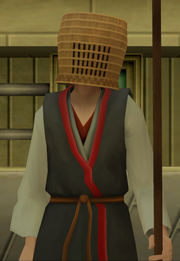
Since chaos is not true buddhism this explains how it can coexist when paranirvana seems like it would be at odds with the goals of most members of chaos. Note that while not all members of chaos seek to lose their self identity, some may still do so as a personal choice, such as mem aleph taking the paranirvana pose, and ceasing to have a personal form. Chaos seems to take inspiration from nirvana in another way, with their association being the idea of non-clinging, and accepting that everything changes.
Despite this, some chaotic members do seem to desire ultimate loss of identity, which is how maitreya recruited gaians in iv. Since chaos is about personal choices, the fact that good and bad chaos figures are on the same side can reflect your actions taking you in either direction you choose.

An interesting thing about buddhism is that you can for the most part only become enlightened in human form, since lower forms are in too much struggle, and devas are in too much peace. Though there are some exceptions for certain types of devas who already began the path. And buddha relates directly with humans more than through the other gods. And it preaches something called the “middle way.” so there is also sole context for whyit's also associated a bit with neutral
Note that humans having the easiest time getting enlightened is something that parts of smt implicitly touch on in that they depict humans as the ones who have the easiest time learning and taking their development in different ways. Since unlike gods and demons in smt who implicitly exist with a specific theme that while they still have free will effects their nature, humans can take their nature in different directions easier. (demons can by changing form too, but do not inherently do so naturally).
While all the games have some dharmic elements, the most notable are dds, and nocturne, in which the different endings correspond to parts of buddhism. Nocturne takes place in the buddhist womb realm, and has a composite mix of cosmic egg, virochana, and brahma presiding over rebirth. The different endings correspond to aspects of buddhism, with shijima being serenity and the static nature of buddhist heaven, yosuga being karma and self-power, musubi being non clinging (here meaning to others), reset being the fortunate balanced nature of human birth, and middle way, and tde being an end to reincarnation.
Types of entities

Devas are a term in both religions for high gods living in bliss. The term is not used often in megaten, but is used to refer to the four devas. A deva in Buddhism is one of many different types of gods who share the characteristics of being more powerful, longer-lived, and, in general, much happier than humans, although the same level of veneration is not paid to them as to buddhas. An important distinstion for both buddhism and hinduism is the distinction between devas and asuras. While originally all gods were called asuras, over time the distinction evolved to refer to the good peaceful ones as devas, and the bad wrathful ones as asuras. These are seperate classes of beings, with devas being a higher class. In buddhism, and many forms of hinduism people via their reincarnation can become one. Though generally do not stay as one forever unless they are liberated from rebirth.
Devas are seen as akin to polytheistic gods of a greek nature. In buddhism they are considered generally benevolent and may protect humanity, but not wise enough to be liberated, something you must learn from the buddha. And in hinduism they are sometimes presented as all representing aspects of the one godhead, fulfilling different roles in reality. This does not stop them from being distinct beings however. In both religions there are beings higher than general devas however, in buddhism that being buddhas (sometimes called devatideva), and in hinduism that being Mahadeva. Devatideva meaning god of gods, and mahadeva meaning great god.
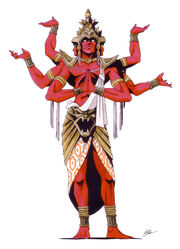
Asuras, are a term for wrathful gods or demigods or demons living in strife. They are mythological lord beings in Indian texts who compete for power with the more benevolent devas, and can be seen as demigods or demons. They are often associated with chaos in game. With the end boss in SMTI leading the forces of chaos being an asura. And it being a boss in SJ. Although asura is a generic term, the asura seen in I is identified to be virochana, identified at one point to be the king of the asura. This tie in is used to depict him as another form of the buddha vairochana due to the similar name.
Interestingly, both devas and asuras are shown leaning more to the chaos side in game. With the four many devas being depicted as chaos leaning, and asuras as well. Both positive and negative dharmic figures tending to show up leaning that way. Note that in zoroastrianism ahuras are good and devas are evil. Whereas in vedic religion asuras are violent gods, but devas are peaceful ones. This inversion is used to depict the asura lord as the demonization of ahura mazda, the god of zoroastrianism.
The term asura also shows up in dds as a term for the AIs from the junkyard, since the humans outside of it were using them to test battle strategy that they planned on later uploading to human soldiers. This whole process being called the asura project.
One of the more important uses of the term is in nocturne for the main character, who is called the hitoshura. Meaning human asura. This has a similar implication of being turned demon, and ties to the story involving a choice to either be reborn as a human or embrace the demonic side.
Ghosts (or spirits) are one of the six main things a person can incarnate as in buddhism, the others being devas, asuras, humans, animals, and hell beings. Pretas are the most well known type of ghost, but yakshas, rakshas, and other nature spirits all show up as part of this category.

Pretas are called hungry ghosts, and like normal ghosts hang around bugging humans. They show up in many games as one of the lowest level demons.
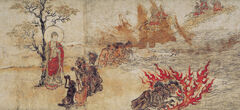
The scene in iva of many pretas worshipping asparas seens to be based on old depictions of pretas bowing to the buddha, and asking for help to relieve their torment.
Mahadeva is a Sanskrit term meaning "greatest god," "most powerful god" or "most supreme god." It is also the name sometimes given to the Hindu god, Shiva. It is used in hinduism to distinguish the supreme gods as a much higher being than the intermediary gods seen between them. In iva it describes how the goal of the gods is to replace yhvh who is in the role of great god.
Saguna Brahman in hinduism refers to brahman with qualities. This is often equated with the higest god, and is consdiered to be "God" proper in hinduism. And is contrasted with Nirguna Brahman which is seen as the abstract brahman that pervades everything but is not an entity proper. A staple of the formation of buddhism is denying that such a thing as brahman exists and that even the high gods are still in samsara. Although some later forms have similar concepts.
An avatar, a concept in Hinduism that means "descent", refers to the material appearance or incarnation of a deity on earth. The relative verb to "alight, to make one's appearance" is sometimes used to refer to any guru or revered human being. Avatar literally means "descent, alight, to make one's appearance", and refers to the embodiment of the essence of a superhuman being or a deity in another form. Most often it shows up in the context of avatars of vishnu. In smti you see vishnu appear in the form of krishna, with it being called an avatar.
In digital devil saga, though this does not match the concept perfectly the demon infected people are called demon tuners or avatar tuners, to imply channeling the power of those gods on earth. Though this in practice had little to do with the nature of the gods, merely being demonic forms but based no their powers.
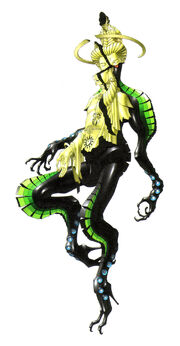
Buddhas are beings in buddhism considered to be the highest divinity, and who are free from the cycle of rebirth. Unlike the highest gods of hinduism, they are not seen as entities in control of aspects of samsara itself, being rather beings whose power and state comes from freeing themself from it. How buddhas are seen varies in different forms of buddhism. In theravada, they enter paranirvana right away and remain there, and so cannot be contacted directly. In mahayana they remain in the world helping others be liberated and become bodhissatvas, which is known as non-abiding nirvana. As far as what happens in paranirvana, it is not easy to describe. It is seen as in a sense losing distinct existence as a particular individual, being spread out among reality. Even that is described as a metaphor though, with the truth being seen as incomprehensible to those still in samsara. The implication is that having a specific body is a limitation, whereas in nirvana existence is unlimited.
How buddhas work can be in a sense compared to the matrix. In buddhism you being born into a new body is seen as a result of your mind. The cycle of samsara you are in is based on how your mind approaches things. Buddhas are freed from samsara, and so are no longer a samsaric entity gaining great power. The reason they can only be described as "awake" is because those in samsara have no context for any way to describe them other than being free from it. Enlightenment is not a mere psychological state, but due to how buddhism perceives mind has connotations of fundamentally transforming your nature. Your mind, and so by extent your body is unbound. This can free you from being born again, dissolving into the dharmakaya, but in mahayana with nonabiding nirvana buddhas can continue to incarnate into the world to help those inside.
An Arhat refers to someone who has achieved enough to free them from reincarnation and the cycle of rebirth, but not to become a buddha. Which is a higher level of achievement that comes with more abilities.
It's often taught that there are two main kinds of obstruction: klesavarana, "obstructions of affliction", and jneyavarana, or "obstructions of knowledge". In the Mahayana, arhats are said to be free of the former but not the latter, whereas buddhas are free of both. While arhats are free from rebirth, they are not seen as divinities in the way buddhas are.
Bodhisattva is a term for the buddhas (or those close to being one) in mahayana who stay in the world system in order to help all beings to enlightenment, and sometimes create their own pure land dimensions to bring people to to teach. Interestingly, parallels to the idea of salvation are drawn, and this idea even spawned its own chinese salvationist group of religions, described in its own section. In the visionary items for SMTI, it was said that en no ozuno was an incarnation of a bodhissatva. Showing an element of buddhism for neutral also.
Interestingly, its also possible that the idea of a bodhissatva or buddha was subsumed into the "messiah" archetype for law, due to the ambiguity of what all messiahs it refers to. Law hero looks more shinto inspired, but may also be meant to capture elements of many religions, such as him being bald like buddhist monks or barefoot. And emptying your own mind to become absolute loosely resembles what happens to buddhas, and is shown similarly with the brain alterations they did to him here to make him the embodiment of law. And since buddhas in buddhism become one under their own power rather than being sent prophets, it can also loosely call to mind the idea of the artificial messiah. Note that the type of entities who fill this role in religion, buddha himself, Jesus, etc, don't make direct appearances really. Meaning that the messiah characters in game are meant to be the stand ins for those types of direct figures. Note however, that in I a buddha statue shows up on the gaian boss rooms at the end of the game. So you can see this multiple ways.
Note that in an interview steven, saint germain, and mido are confirmed to be in some sense free from the cycle of rebirth, making them similar to buddhas or bodhissatvas. A connection they draw deliberately.
Adibuddha. the "First Buddha" or the "Primordial Buddha." is a term used in certain forms of buddhism, although it is not present in most. Ādi means “primordial,” not necessarily referring to a person but to an innate wisdom that is present in all sentient beings. The adibuddha is described as the one mind, or underlying reality of buddhahood that has always existed. And so resembles the idea of brahman, although those buddhists who profess it insist that it is not like brahman, not being an "Essence" per say. It is sometimes treated like a godhead of emptiness, but occasionally treated like a being. Buddhas are said to be avatars of it, manifesting its inherent qualities upon buddhahood, and so venerating one buddha is venerating all.
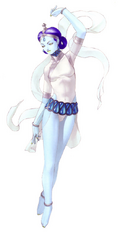
Apsaras also known as Vidhya Dhari, according to Hindu and Buddhist mythology, are spirits that appear in the form of young, beautiful women who have mastered the fine art of celestial dance. They are the wives of Indra's servants, Gandharvas, and are known to entertain the gods and fallen heroes, dancing in the divine palaces to music made by their husbands. They are frequently equated with the water-elemental nymphs and naiads of Ancient Greeks, and depictions of them can be seen in Cambodian and Balinese culture. Both asparas and Gandharvas show up in game, though asparas do more commonly. They are a law demon.
In SMTIV, Apsaras is also the client in the Challenge Quest, Tokyo Bay Mixer. She asks for Vasuki hides so they can make a rope in order for the gods to create the divine wine, Soma, in Tokyo Bay. She is found in Infernal Tokyo's Shinjuku. She is impressed that Flynn defeated two and mentions they'll always need more for the project. The quest can be done multiple times. In V, one shows up in a sidequest in the first area representing law.

Gandharvas are male nature spirits that are said to be the husbands of Apsaras. They are said to be part animal, usually a bird or horse. They guard the soma, the ritual drink of the gods, and are said to make music for the gods in their palaces. Gandharvas are also said to act as messengers of the gods. They are said to follow Jikokuten, one of the Four Heavenly Kings. They tend to show up as a neutral demon.
Note how although the lore generally says that there are only six types of being, (not counting enlightened beings) there are many subclasses of being beneath them. Gandharvas being seen often as a kind of deva.
A rakshasa is a demon or unrighteous spirit in Hindu and Buddhist mythology. It shows up as a demon in game.
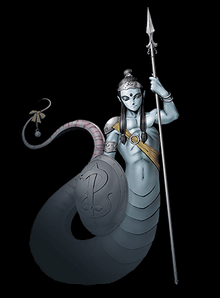
Naga are a tribe of semi divine half-snake half humans. They are said to be the enemies of Garuda. They are also said to be the followers of Koumokuten, one of the Four Heavenly Kings. They live in an underground heavenly realm called pata-loka that despite being underground is said to glisten like it is day due to the presence of so many gems.
While in game they tend to show up listed as neutral demons, in majin tensei ii they are shown as denizens of the heavenly realm of amnesia alongside the angels, likely due to their semi divine status.
Kumbhanda is one of a group of dwarfish, misshapen spirits among the lesser deities of Buddhist mythology. They are known to suck the life out of humans and are servants of the southern Four Heavenly Kings, Zouchouten. It shows up in game as a skeleton horse.
The Kinnari is the female counterpart of the Kinnara, a half-man half-horse being from Hindu myth. They sing praises to the gods. It is a law aligned demon.

A Dakini is a tantric deity described as an embodiment of enlightened energy that resembles a female. In each of her various guises, she serves as each of the Three Roots. She may be a human guru, a yidam or she may be a protector. It was also described as a man eating demon that the buddha converted. In hinduism, it is said they serve the Indian mother goddess Kali and carries the souls of the dead to the sky."
These show up in-game as chaos demons. It seems that there is a trend of not only buddhist things leaning chaos, but specifically tantric buddhist things. This being because these things represent not only violence, but intense practice and self improvement.
Yaksa is the name of a broad class of nature-spirits, usually benevolent, who are caretakers of the natural treasures hidden in the earth and tree roots. They appear in Hindu, Jain and Buddhist mythology as a kind of nature spirit, whose female counterparts are Yaksini. Both show up as chaotic demons.
Gongen. A gongen, literally "incarnation", was believed to be the manifestation of a buddha in the form of an indigenous kami, an entity who had come to guide the people to salvation. The gongen concept is the cornerstone of the honji suijaku theory, according to which Buddhist deities choose to appear to the Japanese as native kami in order to save them, which is based on the Mahayana Buddhist notion of upaya, "expedient means". There are various beings in the games with the word gongen in the title.
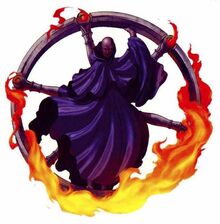
Wrathful deities. In Buddhism, wrathful deities are enlightened beings who take on wrathful forms in order to lead sentient beings to enlightenment. They are a notable feature of the iconography of Mahayana and Vajrayana Buddhism. They are often paired with peaceful figures as a dualistic set. While demonic inappearance, they are seen as good entities and protectors of buddhism. One of the main types of wrathful deity are dharmapalas. There are eight main Dharmapalas. Yama, mahakala, Yamantaka, Hayagriva, Vaisravana, Palden Lhamo, Tshangspa Dkarpo, and Begtse.
In Tibetan art, wrathful deities are presented as fearsome, demonic beings adorned with human skulls and other bone ornaments. Wrathful deities are representations of negative karmas, in the same way as peaceful deities are representations of positive karmas. Yama is sometimes considered a wrathful deity. They are a common figure in tantric practices, where they represent the difficulties and fierce presentation of practice.
Wrathful deities in japan are often depicted with a fiery dharmachakra on their back. In game, the angel throne is depicted in this way, to show the omnipresence of the tantric themes.
Specific gods and figures
there are many gods in buddhism and hinduism, but we will only list the most directly relevant ones. Note how while their significance may be downplayed there are analogues of most hindu gods in some forms of buddhism.
An interesting thing worth noting is that in dharmic religions it is often seen that there can be multiples of gods. If indra died then a new being could incarnate and would be known as the new indra. The role itself being used as a name, despite it being a different being.
This is an aspect in the games, detailing how there can be multiple of certain demons at times, especially if the former one died. Although for named demons it is more uncommon, but not impossible. This aspect not just coming from the fact that demons represent ideas, but having an actual religious parallel.
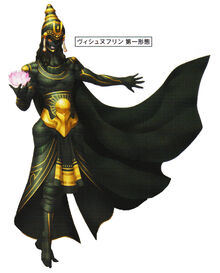
Trimurti. Hinduism has different versions, which have different hierarchies in them. And by extension anything you can say about it may be slightly different in some of the forms. (in fact, before recently there wasn't really such a thing as “hinduism,” because they considered themselves different religions until outside influence defined them by similarities.) But one of the more common appearances (when using it to explain) is where the godhead has three main avatars. The godhead itself is the abstract brahman, which is ubertranscendent and may or may not be considered an entity per say. Obviously it can tie to the great will in this sense. (More about brahman in its own section.) Somewhat literally, if you consider DDS to take place in the same multiverse, since its semi-equivalent to the great will was literally called brahman, due to its hindu themes.
The appearance of brahman in dds2 may be based on the god brahma, which is often depicted with several heads. Though sometimes the multiple gods of the trimurti are depicted as one being. In DDS2, the heads trailing off into infinity shows the relation between the Trimurti, and the abstract brahman. There are other versions, some so different as to simply consider krishna in particular the main god, just to show examples.
But of the sentient gods, the three usually considered main are Brahma, the god of creation, vishnu, the god of preservation, and shiva, the god of destruction (or transformation). Brahma is not considered something to be devoted to, since it only functions at the beginning of the world. Most systems have a main highest god though, and consider it either shiva or vishnu, though in some cases krishna is independently considered the highest god.
Hinduism often professes to be monotheistic though, and these gods are seen as pieces of one God that reflect aspects of it. Though generally, one will be seen as the main god. God in the sentient sense is seen as semi-equivalent to brahman, and a manifestation of its essence, bearing many auspicious qualities but is not totally the same as the abstract ubertranscendent brahman that properly has no qualities. This idea of different gods being aspects of the absolute happens in megaten not only internally to sides, but to the entire system in general, since they all share a vague panentheistic vision, albeit viewing it slightly differently.. (Note, an important aspect of hinduism however is that even aside from the gods, all things are ultimately part of brahman.)

An interesting division here is that shiva is often on chaos race, whereas Vishnu was in I a law demon who was an actual character. (krishna in iva is likewise meant to be an analogue of law ideology of a different kind). And since different hindu sects focus on them differently as who is head god, can be seen as a small explanation of the series as a whole. In IV they even use the word preserve to refer to law, and destroy to refer to chaos, which calls vishnu and shiva directly to mind. So the implication seems to be that the sides are tied to different types of divinity functioning in the world in different ways. But likewise are all part of the great will in the same way shiva and vishnu are both avatars of Brahman. This emphasis on breaking down for the creation of the new is part of the dynamic depiction of chaos.
An interesting additional note for shiva is that one aspect noted about shiva is the fact that it is said that even demons worship him. Which ties to his role as a god over chaos in megaten, in which he is a holy figure for the chaos side, and demons follow him. This is in part because his essence is seen as all encompassing and as like a primal aspect of reality which all bend to. Rather than a force of goodness, which can be opposed like god in christianity.
In smtv, shiva shows up as a kind of extreme neutral entity. He talks about how the world unfolding without any universal rulership, but sees the current world which developed outside of that context as inherently corrupt, seeking to end it so that a new one can begin in its place.
In hinduism obviously shiva and vishnu aren't meant to be seen as opposing forces where one is evil, but working in a kind of harmony, but their powers are sometimes seen as opposed, and in one story they even did battle. And in hinduism, even demons are part of brahman, so its to be understood that different sides still might share in some sense of divinity, even if you think they are wrong. But can simply correspond to the “wrong” type of manifestation. From a neutral perspective in-game it can mean stability and flux are both important forces that need to be in balance. Since despite the “humans” tone seeming to be against the forces, balancing them has long been a neutral thing, even since I, and where it uses a yin yang to show it.
Note that this doesn't mean followers of vishnu are more lawful relative to shiva in real life. Just that here those properties are seen as manifesting in different ethical implications.
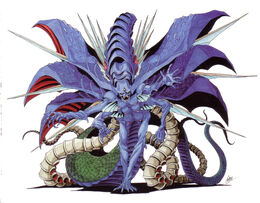
Although god in mainline is depicted in an abrahamic light, aspects of the trimurti do get mixed in with it at times. In smtii, satan obviously is meant to call shiva to mind, relative to yhvh. And in nocturne, kagutsuchi, being god of creation has aspects of brahma. Showing that the figures have a bit of syncretist aspect.
Note that shiva and vishnu and brahma (and sometimes others) are seen as aspects of one entity. In IVA, merkabah and lucifer are seen as aspects of satan. And since they are associated with preservation and destruction gives even his presence a kind of hindu tone, since it makes them the figures who are part of one system controlling the opposing aspect of it. Who are ultimately aspects of one higher entity. Likewise, the actual shiva and vishnu being on opposing sides can relate to neutral wanting to see the forces balanced.

Note that although this is not true to all forms of hinduism, some of them do indeed have beliefs that closely resemble how gods work in megaten games. In some forms of hinduism gods are seen as manifestations of traits and behaviors, sometimes even in a sense where different perspectives change which gods exist. As one moves through levels of understanding in faith, deities evolve from being separate from oneself, to being intrinsic to the individual. There is no hard line between sacred and profane. Essentially, you are the gods by being continuous with them. They have a kind of separate degree of existence in the same way that humans do from eachother. Yet on the absolute scale everything is just illusions that divide the one brahman. And enlightenment is realizing total unity. However, this is not true to all forms of hinduism however, some of which holds the distinct beings as distinct in a more absolute way.
The gods are often depicted in hermaphroditic forms to represent the deeper unity of different things. The main gods often have specific forms that are split down the middle between them and their consorts. The theme of this shows up in DDS2, for example, "Seraph" was based on Shiva and Parvati fusing and becoming a hermaphrodite. As is jenna angel.
Buddha. Buddhism begins as rejecting the status of the hindu gods in a sense though. Where in hinduism the gods are in control of the world, buddha downplays them and says that the hindu gods while still gods are stuck in samsara themselves. And so while you can pray to them and they may be wiser than you, you shouldn't necessarily see them as infallible. Likewise, Buddha denied the existence of a universal brahman.
Atheists sometimes try to use this to try to crowbar buddhism into atheism, but the reason he did this was actually to up play himself as something which translates to god above the gods. He said he wasn't a deva since he was an even higher entity. Later buddhism had something similar to brahman, but much less explicit, and had the buddhas stay in samsara to help people even after liberation. It has other buddhas as well, and in some forms even wrathful deities who are said to ruthlessly persecute the enemies of buddhism. Buddhism in game often sways slightly chaos, though neutral, and to a lesser extent law also have buddhist influences.
Buddha began life as a human named Siddhartha Gautama who was divinely conceived. He was raised closed off in a palace by his father who had a prophecy that his son would either become a great ruler or a holy man depending on how he was raised. So his father raised him without ever letting him leave the castle walls so that he could be raised to be a leader, and he knew little of the suffering of the world outside. He begged to be let out when already a married adult and his fatner finally relented.
When he was outside he began to understand the reality of human suffering. He left his home to become an ascetic of the variety who would often starve themselves, almost dying in the process before realizing such extremes were not helpful. He reached enlightenment, achieving great spiritual power and divinity. He however thought that his practice may be too difficult for most people and so was not sure whether to tell others until the king of the gods came down to ask him to do so. While scholars agree that he was a real person, few details of his life are known for sure.
While buddha himself does not appear in the games, the gaian temples do have a statue of what looks like him, due to their appearance being based on buddhism. But the connotations are stated to be fairly different, due to their beliefs now having moved on significantly form buddhism, having embraced both life and violence.

Ganesha is one of the best-known and most worshiped deities in the Hindu pantheon. Devotion to Ganesha is widely diffused and extends even to some to Jains and Buddhists. Although he is known by many attributes, Ganesha's elephant head makes him easy to identify. Ganesha is widely revered as the remover of obstacles, the patron of arts and sciences and the deva of intellect and wisdom. As the god of beginnings, he is honored at the start of rituals and ceremonies. Ganesha is also invoked as patron of letters and learning during writing sessions. His elephant head was given to him when shiva cut off his human head due to him being placed as a guard for shiva's wife who tried to bar shiva from seeing her.
Although never a major figure, ganesha often shows up on the law side. Having a speaking role alongside the army of angels in Strange journey, and being one of the non angel enemies in purgatorium in IV. To imply some syncretism between religions.

Krishna. In Hinduism, Krishna is the eighth avatar of Vishnu, the Preserver. Described as a blue-skinned young boy playing a flute, he battled many demons and waged war alongside a man called Arjuna. He is a famous deity in the Mahabharata and he is believed to have written the Bhagavad Gita. He is one of the primary figures of hinduism.
Note that hinduism crowbarred buddha into it by saying that he too was an avatar of vishnu, rather than a competing idea. In smt I the demon showing up on law with the name vishnu has the appearance of krishna. In smt IV final, krishna appears to be the de facto leader of the polytheist side, despite hinduism's arguable monotheism. Note that in SMTI ravana is battling krishna an incarnation of vishnu rather than vishnu's divine form, making vishnu and shiva implicitly on the sides of law and chaos but not directly engaging in the last fight with their divine bodies on earth. Similar to how yhvh himself is not seen in the game.
Krishna's story involves his uncle who was a tyrant receiving a prophecy that krishna would one day depose him, and so trying to kill him even when young. Krishna was brought into hiding and grew up as a mischievous boy whose pranks earns him the nickname a Makhan Chor (butter thief). Krishna's childhood reinforces the Hindu concept of lila, playing for fun and enjoyment and not for sport or gain. When he grows up he meets with the warrior arjuna and fights with him to depose his uncle.
Krishna's main wife is Radha, though he was seen as taking many other wives to preserve their dignity for they were seen as unfit for marriage. At some point krishna realizes his divine heritage, and preaches to arjuna about ethics and metaphysics, which is the writings of the Bhagavad Gita. He was killed on accident by someone's arrow who believed he was a deer due to a curse that was placed on him, and forgives the hunter before dying. Though there are laternate versions of his story.
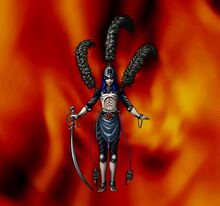
Rama, also known as Ramachandra, is a major deity of Hinduism. He is the seventh avatar of the god Vishnu, one of his most popular incarnations along with Krishna and Gautama Buddha. (who in hinduism is seen as an avatar of vishnu). In SMTI, vishnu taking the form of krishna mentions that he in the past defeated ravana in the form of rama, which corresponds to his actual lore. Showing that he appears in that world in the different forms associated with him in order, but using the name vishnu when identifying as his godly self. Rama himself shows up as a demon in a few games.
Kalki is the tenth and final of the Dashavatara (the ten Avatars) of the Hindu deity Lord Vishnu. Krishna in IVA refers to flynn as this. Since he uses flynn as fusion material to become vishnu. He also shows up separately as a light neutral demon in SMTII.
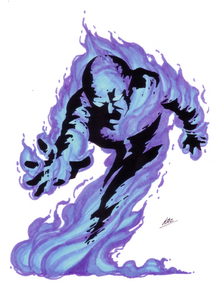
Agni is one of the most important of the Vedic gods, being the god of fire, receiver of sacrifices and the messenger of the gods. Agni lives in everyone's hearth. Being the vital spark of life itself, his importance was so great to the Proto-Aryans that he had over 200 Hymns ascribed to him in the Rig Veda, along with eight of its ten books started with praise towards him. Agni is closely associated with Indra, sometimes there being descriptions stating that they're twin brothers. He is likewise a major god in buddhism also.
Whenever a description of Agni is given, he always has two faces. He has seven fiery tongues with sharpened golden teeth. He has red skin, wild black hair, and black eyes. He has seven arms and three legs, and seven rays of light emanate from his body, and either rides on a ram, or on a chariot, pulled by goats or sometimes parrots. In smti he shows up as tenma race as a light chaos being. In keeping with the consuming and unpredictable nature of fire.
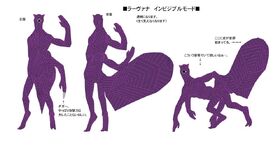
Ravana is the primary antagonist of rama in the ancient Hindu epic Ramayana where he is depicted as a Rakshasa, the Great king of Lanka. Ravana, a devotee of Lord Shiva, is depicted and described as a great scholar, a capable ruler and a maestro of the veena (plucked stringed instrument). He is also described as extremely powerful and has ten heads. His paramount ambition was to overpower and dominate the devas. In SMTI vishnu in the form of krishna is at odds with him. And in dds he is the demon form of colonel beck. Note that as shiva is listed as chaos aligned in most of the games, this can implicitly imply shiva as working for, or at least leaning towards chaos in smti.
Ravana is worshipped by Hindus in some parts of India, Sri Lanka and Bali (in Indonesia.) He is considered to be the most revered devotee of Shiva. Images of Ravana are seen associated with Shiva at some places. Notice how this dual perspective on him as a villain in one sense but a good devotee of shiva in another corresponds to vishnu being on law and at odds with him, but him being on the side of chaos who shiva is also on.
Indrajit, meaning Conqueror of Indra, appeared in the epic of Ramayana as the son of Ravana, the king of Lanka. His original name was Meganada for the battle cries he made sounded like thunder. He was named Indrajit by Brahma when he defeated and humiliated the king of daevas Indra, of whom Brahma asked to be released, and in return granted Indrajit many celestial weapons, and the boon of invincibility.
In SMTI he likewise shows up as an opponent, trying to kill you for revenge if you beat ravana in battle. He also shows up as a seemingly unbeatable demon in dds2, who becomes the second to last boss. In reference to him defeating indra in battle he kills roland whose atma avatar was indra.
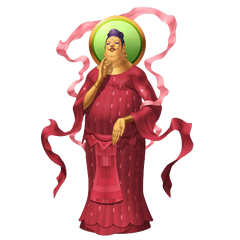
Maitreya / miroku. According to Buddhist tradition, Maitreya is a bodhisattva who will appear on Earth in the future, achieve complete enlightenment, and teach the pure dharma, being a successor to sakyamuni, the buddha of the present. The prophecy of the arrival of Maitreya refers to a time in the future when the dharma will have been forgotten by most of the world.
The most important appearance of miroku is referenced in the miroku sutra in nocturne. Here, interviews point out that in this scripture miroku is seen not as a buddha, but as a god of salvation associated with eschatology, destruction, and rebirth. While in nocturne kagutsuchi takes a role akin to virochana as the underlying power, and the reason bearers take a role akin to miroku, being the one trying to enlighten others and spread their salvation, the in-game use of the word miroku doesn't appear to refer to any specific person here. But to be a personification of the entire process of the death and rebirth of the world.
While it is kagutsuchi's power being used, kagutsuchi exists as a kind of fueling agent. And so the text seems to lump this all together as a description of one process. Similar to how in buddhism due to the concepts of emptiness it stresses the lack of of fundamental distinction between buddhas. Miroku is described as if a single figure even though it is crediting what would in theory be the reason bearers with the process of destruction and rebirth overseen by kagutsuchi. And so it is blurring them together slightly.
Maitreya also shows up as one of the main figures on the side of the divine powers in IVA. In this game he represents an extremist idea of the buddhist ideal of non clinging, applying it to the idea of not being attached to others. He also talks about the goal of paranirvana.
Note that the fat buddha statues are known as budai, or the laughing buddha. A historical figure who claimed he will later ve born as maitreya. He has become incorporated into Buddhist, Taoist and Shinto culture. Many people confuse the laughing buddha with buddha himself, but they are distinct figures. The depiction of maitreya in IVA is obviously based heavily on the laughing buddha. Though it does also contain some of the more stern aspects of the normal maitreya figure.general.

Virochana. In vajrayana buddhism, vairocana, also known as Dainichi Nyorai is often seen as the adibuddha, an embodiment of the primordial aspects of mind that have been enlightened since eternity, never having existed in samsara. When personified, he is often depicted as existing across many worlds, as opposed to normal buddhas which only come from one. Despite this, buddhists stress not to treat adibuddhas like a monotheistic force, and often describe them not as an entity per say. Or at least not like an entity in any way we'd normally understand.
While vairocana exists as a side boss in the abyss who presides over his own realm, the more relevant depiction of him is as part of the composite figure called kagutsuchi in nocturne. Vairochana is associated with the womb and diamond realm mandalas, and in nocturne the game takes place in the womb realm. At the center of the realm is kagutsuchi, who takes the form of the sun, the sun being considered something vairochana embodies, showing the figure's composite nature.
The reference to the figure of vairochana is to represent the idea of spiritual growth and development. But unlike classical ideas where growth only has one direction, nocturne takes an existentialist stance where the reasons represent perspectives, and your personal choice is reflected in a different constructed world. Since kagutsuchi is also a composite figure that includes the cosmic egg, this process of choice is reflected in the birth of a tangible world based on your perspective, and the culmination of your growth at the end of your journey.
When considered an abstract embodiment of emptiness, the adibuddha is considered as acting through the tangible buddhas, and that those buddhas are the forms of it. As such, this may be an inspiration for the relationship between the various avatars and the idea of god in the games, where god is described as in a sense nonexistent.
Note there is also an asura named virochana in hinduism that may be an inspiration for the buddhist figure. Which is why raidou 2 implies that the asura lord from smti and vairochana from raidou 2 are actually the same being. In japan, some forms of buddhist shinto hybrids considered amaterasu the same entity as vairocana, since they were both associated with the sun.
In dx2 there is a side mission where you believe that virochana is merging the human and demon worlds to force humans to dissolve into an equivalent of paranirvana, being freed from rebirth. However, you eventually realize that he only offers this to those who seek it, and that the one merging the worlds to try to force everyone into this fate is a human. You eventualy conclude that it would be wrong to prevent those who suffer from taking him up on his offer, and part on good terms with him, saying that while you see the logic in humans diving into paranirvana to get rid of suffering, that you believe that there are some truths you can only uncover as an individual living a life that contains suffering.
Vairochana's role in SMTII seems to have been diminished from the original drafts. Early drafts for smtii suggest that there was going to be a plot point about some gaians following vairochana rather than lucifer, due to lucifer not showing up in the end of smti. This plot point is similar to apocalypse how a segment of them began following maitreya rather than lilith.
Fudou Myouou is the Japanese name for Acala, one of the Five Wisdom Kings of Vajrayana Buddhism. Acala means "Immovable", meaning how Acala is not moved by temptations of worldly desires. In Japan, Fudou Myouou means the "Immovable Wisdom King". He is the wrathful emanation of the Cosmic Buddha, virochana. Interestingly, while virochana is on the chaos side, fudou myouou is one of the few buddhist figures on law.
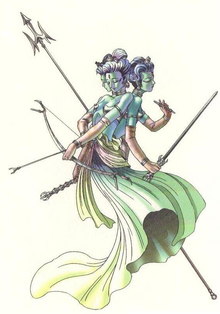
Marici (or Marishi-ten in Japan) is a solar deity of light and the heavens and a tutelary deity of the warrior class who is revered in many schools of Buddhism. Marishiten in Japan is also believed to be a non-standard member of the Seven Lucky Gods who is largely supplanted by Benzaiten. She is also believed by some to be the consort of Dainichi Nyorai and is the harbinger of Dainichi, associated with the blinding rays and fire of the rising sun, and thus with the power of mirage and invisibility. She is also a part of a group of three deities called the Santen, alongside Benzaiten and Daikokuten. She shows up as a blue multi headed godess in-game. She shows up working for the divine powers, protecting the jars in iva, and in iv as a godess who challenges flynn to spar.
Indra. In the Vedas, Indra is the king of Svarga (Heaven) and the Devas. He is the god of lightning, thunder, storms, rains and river flows. Indra is the most referred to deity in the Rigveda. He is celebrated for his powers, and the one who kills the great symbolic evil named Vritra who obstructs human prosperity and happiness. Indra destroys Vritra and his "deceiving forces", and thereby brings rains and the sunshine as the friend of mankind. His importance diminishes in the post-Vedic Indian literature where he is depicted as a powerful hero but one who is getting in trouble with his drunken, hedonistic and adulterous ways, and the god who disturbs Hindu monks as they meditate because he fears self-realized human beings may become more powerful than him. In some buddhism he is also referred to as the king of the gods.
In SMTI he is depicted as law aligned and deity race, but moves to neutral due to the race as a whole moving that direction. Interesting in that most buddhist things are chaos leaning, but he is law, being the king of devas. So there is a slight association between law and devas as well.
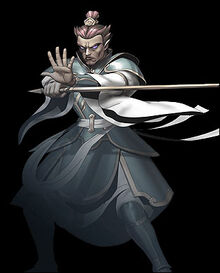
The four devas or the four heavenly kings are four Buddhist gods, each of whom watches over one cardinal direction of the world. Their names are Bishamonten, Jikokuten, Zouchouten, and Koumokoten. All four Kings serve Śakra, the lord of the devas of Trāyastriṃśa. On the 8th, 14th and 15th days of each lunar month, the Kings either send out emissaries or go themselves to inspect the state of virtue and morality in the world of men. Then they report their findings to the assembly of the Trāyastriṃśa devas. On the orders of Śakra, the Kings and their retinues stand guard to protect Trāyastriṃśa from another attack by the Asuras, which once threatened to destroy the realm of the devas. They also vowed to protect the Buddha, the Dharma, and the Buddha's followers from danger.
The four devas often show up in megaten games, often chaos aligned although they often fight for neutral. In devil survivor, killing one of them is what made it possible for demons to get through and be summoned into japan, and replacing him in the end on one of the routes prevents them from continuing to be able to get in. So they are presented as figures who seem to be more close to the neutral side, despite having chaos attributes, helping keep demons off of the surface. Note how many of the demons you see are implied to be under their command.
Lokapala is a term that in buddhism refers to the four devas, but in hinduism the guardians of the directions. It is the name for roland's group in dds2.
Sanat kumara. In hinduism, sanat kumara is a poet, and the son of krishna. His depiction in the games is more related to theosophy however. His appearance may be based on the thousand arm buddha.
The Garuda is a large mythical bird or bird-like creature that appears in both Hindu and Buddhist mythology. In Hindu mythology, a Garuda is a lesser Hindu divinity, usually the mount of Vishnu. It shows up in many games as a law demon. Gurr is seen as a demonization of garuda, and shows up as a seperate demon.

Shesha is the king of all nagas according to Hindu mythology and one of the primal beings of creation. He is sometimes called Ananta Shesha which means "Endless Shesha" as he is said to hold all the planets in the universe on his hoods. He is usually depicted as a massive coiled serpent with as many as five to one thousand heads, sometimes wearing an ornate crown on each head. The heads are not only venomous but spew fire as well.
Shesha is used by Vishnu as a bed, and he is often found sleeping upon his back. Shesha will also constantly be found singing about the glories of Vishnu from all his many mouths. At the end of each Kalpa (time period allotted to the earth) the serpent destroys all creation. The japanese dragon kuzuryu derives from this, but the kuzuryu in II seems to be a composite figure of both entities. Since it is used as a superweapon that could destroy the world, and seemed to span it. He is also known as Ananta which means infinite, to imply his scale.
Aside from that appearance, he also shows up separately as a random demon. More importantly, he later shows up in IVA being a super demon that others struggle to fight against. One which helps create the cosmic egg, which births a new universe, calling to mind his nature as a primal entity. In iva his head is meant to look like a lotus, a dharmic symbol.

Guan yin. "Kanzeon" is the Japanese name given to the Chinese goddess of mercy and compassion, Guan Yin. According to the teachings of Buddhism, she originated from the Bodhisattva Avalokiteśvara, who was sometimes seen as a male figure, but is now generally thought of as female. Note how for buddhas, appearing in those alternate forms can be done regardless, since they are seen as transcending ordinary concepts of sex.
Her being is mostly depicted as a beautiful woman wearing a white robe and carrying a jar of pure water and a willow branch. In her meditations, she attempted to aid the ones who needed her, but with only two hands at her possession, she was unable to do it until Amitabha Budha, her spiritual teacher, gave her a thousand arms so that she could complete her task. Guan Yin is so popular in East Asia regions that she received different names. Her origin and history in each region also differs from one another. She shows up as rise's ultimate persona in persona 4.
Amitabha, also known as Amida is the primary buddha of pure land buddhism. He takes on a salvationist role in that if you chant his name and venerate him in life, he can bring you to his pure land upon death, where you can remain until you reach liberation. Before he became amitabha, he was a monk named Dharmakara, who is often depicted with red skin.
Amitabha shows up as a character in smtv, though he bears little resemblance to his religious counterpart. In game, he functions as a guide, helping the throne of creation be filled after it lost its previous god, though he says it doesn't matter to him who ultimately fills it. He also describes himself as the light of creation, implying having a role similar to kagutsuchi from nocturne, although in this game it is never explained what exactly his role is in relation to the system. The system of the replacement of gods is called the mandala system in-game, which gives it a buddhist tone, despite being used as symbolism fairly loosely. Amitabha appears as a monk named goko, though his appearance implies the guise of dharmakara. In smti, there is also an item sold in the neutral church called amida beads.
Sadhu. A sadhu is a religious ascetic, mendicant (monk) or any holy person in Hinduism who has renounced the worldly life. It shows up as an enemy in if...

Mahakala is relied upon in all schools of Tibetan Buddhism and is depicted in a number of variations, each with distinctly different qualities and aspects. He is also regarded as the emanation of different beings in different cases, though he is best known as a wrathful manifestation of Avalokiteshvara, the bodhisattva of compassion. He is a Dharmapala (Dharma Protector) and one of the eight main Dharmapalas, alongside Yama, Yamantaka, Hayagriva, Vaisravana, Palden Lhamo, Tshangspa Dkarpo, and Begtse. In Hinduism, Mahakala is a name of Shiva.
Mahakala is typically black in color. Just as all colors are absorbed and dissolved into black, all names and forms are said to melt into those of Mahakala, symbolizing his all-embracing, comprehensive nature. Black can also represent the total absence of color, and again in this case it signifies the nature of Mahakala as ultimate or absolute reality. Mahakala is almost always depicted with a crown of five skulls, which represent the Five Wisdoms.
The most notable variation in Mahakala's manifestations and depictions is in the number of arms, but other details can vary as well. For instance, in some cases there are Mahakalas in white, with multiple heads, without genitals, standing on varying numbers of various things, holding various implements, with alternative adornments, and so on.
While he shows up on the chaos side, as a random demon, the more important relevance he has is that satan's appearance in II seems to be based on him. This likely being because zayin's process of development in II shows a tantric accomplishment of identifying with deity rather than seeing it above you, and ultimately seeing it as empty. Though his appearance is likely also meant to call shiva to mind.
In SMTII, the god daikokuten was derived from the buddhist mahakala. This may be relevant to smtii, because daikokuten is a god of wealth, and satan is equated with modern materialist wealth generation in smtii interviews due to hos ties to anthrosophy, and may add an additional layer to satan appearing as mahakala.

Mahamayuri is One of the Buddhist 5 Vajra-rajas (wisdom kings). They are personified by peacocks because of their habit of preying on snakes (nagas) and symbolize the resistance of terror and disaster. In Vajrayana Buddhism, she is thought to be one of the avatars of Gautama Buddha. In SMTIV it shows up as a boss in infernal tokyo who is chaos aligned, although notably seems to be male in the game.
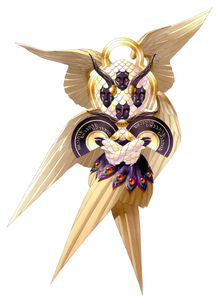
the angel seraph may also be based on the aesthetics of mahamayuri and the wisdom kings. It has the double halo, which is more common in buddhism, and its colors and stance are reflective of the buddhist meditation posture, and its wings resemble a peacock's due to the eyes. If this were the case then, it would be another example of angels taking on tantric aesthetics, alongside satan and throne. Further evidence for this is that mahamayuri in game has angel wings, showing them making that association themselves. One potential reason for this may be their role of fighting the snake nagas being associated with angels fighting snake demons.
Mahābrahmā is a term for a top god of the tangible heavens in buddhism. And is often part of a story of how he believed himself to be a creator god due to being the first god born in the cycle of his area, with others being born seemingly in response to his loneliness. These gods then go on to be born as humans teaching that they were created by him, which is an accident. There are Buddhist stories about him being corrected about this. But he is still seen as a wise entity one could get a chance to spend an eon with if they excel at practice. Although no direct association is drawn to this in game, the act of rejecting that yhvh is the true creator of all in the absolute sense can have a parallel to this story, and a ppotential element of buddhism leaning to chaos.
The cosmic egg, or world egg is a mythological motif found in the creation myths of many cultures and civilizations. Typically, the world egg is a beginning of some sort, and the universe or some primordial being comes into existence by "hatching" from the egg, sometimes lain on the primordial waters of the Earth. One of the earliest ideas of "egg-shaped cosmos" comes from some of the Sanskrit scriptures.
The Sanskrit term for it is Brahmanda which is derived from two words- 'Brahm' means 'cosmos' or 'expanding' and 'anda'means 'egg'. Certain Puranas such as the Brahmanda Purana speak of this in detail. The Rig Veda uses a similar name for the source of the universe: Hiranyagarbha which literally means "golden fetus" or "golden womb". The Upanishads elaborate that the Hiranyagarbha floated around in emptiness for a while, and then broke into two halves which formed Dyaus (Heaven) and Prithvi (Earth). The Rig Veda has a similar coded description of the division of the universe in its early stages.
Obviously the specific depiction of the cosmic egg in IVA may be a mixture of different formats. In IVA a cosmic egg is made by shesha which can birth a new universe. In SJ the term is used more generally to refer to eggs which can transform the schwarzwelt into something that can shape the world. The cosmic egg also shows up in nocturne, since kagutsuchi is also meant to be the cosmic egg, being literally meant to look like an egg. Being part of the game's depiction of rebirth.
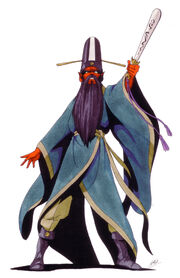
Yama. In both hinduism, and some buddhism, yama was seen as the judge of hell. It seems like in smt he is a lesser version of something like satan who works for the chaos side. This association in part being due to his association with being a lord of hell in general. But in general also because many dharmic figures lean that way. In desu, he also shows up as a demon for keisuke at the point he gets enraged and wants to judge others.
Kamen-Hijiri is a gaian race human enemy in the series. Meaning Masked Monk. Hijiri it is a Buddhist monk who goes on a pilgrimage. Showing one of the chaotic slants in game of eastern religion. Ironically, even if the gods are more split, what it is is that gaian race and their temples looks and relates more with eastern things, whereas messians look more western.
Hijiri obviously also is the name of the character in nocturne who is often hypothesized to be aleph reincarnated, due to the similarities in the descriptions of his backstory.

Mara, in Buddhism, is the demon that tempted Gautama Buddha by trying to seduce him with the vision of beautiful women who, in various legends, are often said to be Mara's daughters. In Buddhist cosmology, Mara is associated with death, rebirth, and desire. Nyanaponika Thera has described Mara as "the personification of the forces antagonistic to enlightenment."
Note of course that this means that he is not necessarily as evil as some western demons. Since preventing you from enlightenment by enticing you to remain in the world is different from direct evils or trying to get you to hell. Since both pro and anti enlightenment buddhist figures tend to be associated with chaos, this can perhaps show a distinction between personal choices. These figures both being about ways you can take your life more than about direct harms or benefits done to others. Mara's mount is the elephant grimehkala, though ironically they are never shown together in-game.

Gozou tennou, Literally, "ox-head-heaven-king." Also called Gion Tenjin, Gozu Tennō is a product of kami-buddha "combinatory" religion. Originally a small scale deity of pestilence in india, the idea of him made its way through china and ultimately to japan, mixing with various ideas along the way. The deity became associated with the legend of a Japanese kami of plague called Sominshōrai and was identified with the kami Susanoo; taking on a trinitarian nature that incorporated characteristics of Susanoo's consort and child, he also came to be identified with the Japanese kami Onamuchi.
On the popular level, however, Gozu Tennō's chief features continued to emphasize his nature as a deity of epidemic disease. With origins as a spirit causing disease, Gozu Tennō was in time transformed into a tutelary that protected its worshipers from such epidemics, taking on further characteristics as a deity of justice, a deity that ascertained truth (Tadashi no kami), and a deity of the cardinal directions.
In nocturne he is presented as the leader of the mantra. His demonic appearance and nature likely reflects his existence as a god of diseases. Him being used in this role likely tying to susano-o's similarities to baal. Later in iv, they said baal was known as gozutennou in the game.

The twelve guardians of Yakushi-Nyorai (the medicine buddha), are protective spirits who each possesses an aspect of the Twelve Sacred Animals from Chinese calendar. In-game they seem to be working under Atavaka, and are on the chaos side. The twelve are Hindu yaksa who were later incorporated into Buddhism as protective warriors. In Japanese sculpture and art, they are almost always grouped in a protective circle around Yakushi Nyorai -- they are rarely shown independently.
Their main function is to protect Yakushi Nyorai, to protect those who read/believe in Buddhist writings that expand faith in Yakushi, to fight the enemies of Buddhism, and to wage war on sickness. However, despite them appearing as the symbols of the astrology, their appearance may be more related to buddhism. Note how astrology tends not to be associated with law.
Vajragarbha is one of the four great bodhisattvas appearing in the Flower Garland Sutra. He is depicted as asking the buddha why so much ignorance exists in the world, in spite of buddha nature. In SMTIs visionary items, en no ozuno is depicted as in his original life being an unknowing incarnation of vajragarbha. Note that en no ozuno being in the diamond realm gives neutral a bigger behind the scenes buddhist tone. Interesting, considering that the neutral religion looks more shinto, whereas gaianism looks more buddhist. Note that incarnating as a human matches the neutral emphasis of divine figures who relate more to humanity.
Niō or Kongōrikishi are two wrathful and muscular guardians of the Buddha standing today at the entrance of many Buddhist temples in East Asian Buddhism in the form of frightening wrestler-like statues. They are dharmapalas who are seen as manifestations of various figures, such as bodhisattva Vajrapāṇi, Mahasthamaprapta, the bodhisattva of power that flanks Amitābha in Pure Land Buddhism, virochana, or as Vajrasattva in Tibetan Buddhism.
According to Japanese tradition, they travelled with Gautama Buddha to protect him and there are references to this in the Pāli Canon as well as the Ambaṭṭha Sutta. Within the generally pacifist tradition of Buddhism, stories of dharmapalas justified the use of physical force to protect cherished values and beliefs against evil. In SMTI you fight a boss named niou in reference to this, and many gaian temples also have statues representing these figures. So there is a tone of chaos being associated with buddhist dharmapalas as a whole.

Kṣitigarbha, also known as Jizo, is a bodhisattva primarily revered in East Asian Buddhism and usually depicted as a Buddhist monk. His name may be translated as "Earth Treasury", "Earth Matrix", or "Earth Womb". Kṣitigarbha is known for his vow to take responsibility for the instruction of all beings in the six worlds between the death of Gautama Buddha and the rise of Maitreya, as well as his vow not to achieve Buddhahood until all hells are emptied.
Imagery of him often shows him traveling to hell realms to protect the beings there from further suffering, especially if they are children who end up there through no fault of their own. Such as by dying early in life before they have a chance to obtain good karma, while still having bad karma from a previous life, or which they obtained inadvertently. He is therefore often regarded as the bodhisattva of hell-beings, as well as the guardian of children and patron deity of deceased children in Japanese culture, where he is known as Jizō or Ojizō-sama, the protector of children.
Kṣitigarbha's main appearance in the games is in the first majin tensei. He shows up in the demon world, presented as a figure who protects over small and weak and young demons. He shows up in a mission where you see a lot of weak demons who are not agressive, and if you kill any he angrily berates you and it locks you into the bad ending of the game. In addition, in the gba games, one of the visionary items is a jizo statue. Jizo statues are a common practice to be used to represent lost children.
Cosmology
Samsara refers to the world system of the universe in Hinuism, Buddhism, and in other Indian religions. Samsara is often represented as a wheel which spins endlessly, with individual realms and people caught up on the inside. And which the only freedom from the endless cycle is in buddhism enlightenment (though in hinduism there is a few ways). For those who are not enlightened, they undergo an endless series of rebirths based on their karma.
In buddhism this is usually seen as either ultimately uncreated, or it is unknown why it exists. And Buddhism usually posits its creation as unknowable. In hinduism however, some forms present it as created by god, but others say that even he may not know why creation exists. Both religions often say that time goes back to infinity though, having an unlimited amount of universe cycles, in contrast with abrahamic religions that posit an absolute beginning.
Note that this idea of the beginning being indefinable is similar to in nocturne when the question of why the worlds are reborn is called the unanswerable question. Since why yhvh or mem aleph creates worlds or people seems to be something that the demons at least claim to know, it means that they are probably referring to an even higher meta level of reality. The cycle of the great will in general.
Note that the religions do believe they know the beginning of each cycle. In hinduism there are different beliefs, but one is that each cycle is ended by shiva, (at the point the world is considered beyond saving, and just needs to be started over, something ironically associated more with law, despite shiva not being so. Chaos does do this at times though also, like in strange journey.) and begun by brahma. In buddhism it just happens naturally. But these cycles have been going on backwards to beyond comprehension. Presumably to infinity. So the question of its ultimate beginning was seen as unknowable, or possibly not even definable. Hinduism suggests that only the highest God knows, or maybe not even him. And that the gods may be products of reality rather than the ultimate beginners of it. Buddha refused to answer the question.

In the world system of both religions you reincarnate in life based on your karma, which is accrued by your actions, mainly moral ones. karma wasn't necessarily seen as divine or always as a judgment, but just cause and effect in general. Though in both some forms of hinduism and buddhism, sometimes divine forces were seen as occasionally moderating it, or at least able to interfere with it. In the case of buddhism, usually positively.
In both, there was a series of worlds you can reincarnate in. They are close to identical, but I'll describe the buddhist one. There's six “worlds” which you can be born in. But they refer to what you can be born as. A hell being, a preta (basically a ghost), animal, human, asura, or deva. Hell beings are lower than pretas and are born in hells, and are trapped there. Pretas can wander the world, but tend to stay out of sight. The hells are called narakas (where naraku got its name in IV).
Earth is shaped like a flat disk with a mountain in the middle, and four tiny islands on it so far from eachother that no one could ever reach them from eachother. Asuras live on the foot of the mountain, and above them live devas on varying levels of heaven. Asuras are wrathful gods. They constantly wage war with eachother and with the devas, but the devas are of a higher nature, so the asuras never win. Generally, only the lower devas have to fight, and they do so offhandedly due to being much stronger. What's more, the higher of a level one was the less visible they were to lower levels. Shown with a similar idea with mem aleph and the super bosses in IV who were invisible and hard to discern even more than normal demons were.
Note that the karma created by actions in one's life effects other lives even aside from just the form of human or god. This has to do with the buddhist idea of the mindstream which preserves different properties which tend to manifest to some degree in future lives even if not immediately. I.E. the buddha incarnated into his last life before enlightenment, knowing that the properties of his wisdom would inevitably arise, even though once born he lived as a prince in ignorance for a long time. This mindstream then preserves an aspect of these properties across lives even if the immediate life does not automatically have them, just a higher inclination to get them.
Not only are these words stacked vertically on top of eachother, there are also different horizontal worlds, which are all similar, and all have this same cosmology layout over again. The amount of these is seen as staggeringly large, possibly even infinite. And in some versions they would even say that different “versions” of the gods which were in their own worlds would live there. (true for both buddhism and hinduism) And it was implied that the people in any given horizontal world mostly stayed in their own. This relates to in series different worlds which are similar and seem to have different versions of the same demons and countries.
In the same way that people are reborn the worlds are reborn also. Worlds had a limited life cycle and would be reborn endlessly, (or until all life within it was enlightened) similar to the depiction as seen in nocturne.
As for SMT, its cosmology seems to imply something similar. Reincarnation is a core staple, though some fission or fusion might happen in between. And karma is mentioned multiple times in series. The souls of people and demons are sometimes treated as continuous, and so it is possible that people likewise by their karma can be born in different realms as a demon or human. Which is why in strange journey at the beginning demons call themselves your fellow bearers of karma. Possibly corresponding to their actions and alignment in life, implying that you incarnate as something reflective of your mind and slant.
But likewise, worlds themselves can be transformed. Most universes seem to center around a main human world that is the center with demon realms of various kinds relating to it. It seems like reincarnations generally happen within a single world system. DDs also talks about karma in a more immediate sense, talking about it as a form of causality that effects your growth as an individual. Which is consistent with its religious usage.
Note that karma doesn't just effect rebirths in these religions, but is tied to causality in general. This is something also shown in game. Where in dds your ability to unlock new things is referred to using the terms karma, implying causality based on your actions similar to the concept of experience. And In strange journey they talk about the schwarzwelt arriving due to the karma of mankind, implying a causal relation. So karma in general is meant to be seen through the light of causality, effecting where people end up. Chaos seems to use the idea of karma as a justification for hierarchy, saying if you die it's your own fault.
Demon worlds here are not inherently bad things from a megaten angle. Chaotic ones are something some might seek on purpose. Note the interesting thing here is that if you interpret karma as non divine, but merely cause and effect, then a humanist interpretation of neutral makes sense. Your afterlife for many waould ideally be being reborn on your own world among more humans, with no gods directly involved in the process. And which neutral ones seem to leave you to yourself for. Note that in nocturne, in the amala you are told that rebirths are related to karma, but that hijiri had his totally overridden. So they are kind of trying to express an eastern seeming cosmology. But one without an obvious “better” path.
Yama is the judge of hell in hinduism and some buddhism. So him showing up as a chaotic figure seems to just be implying that there aren't really “hells” proper, but merely more chaotic demon worlds. You never really see anything corresponding to a pure torture hell, which seems to be more of a rhetorical device (though corrupt versions of yhvh do seem to imply that they have ways to make existence unpleasant for you). To the angels, they a few times allude to the demon world as hell, since its a prison to keep demons away from earth when a barrier is maintained. Something that neutral gods seem to agree is a good idea, though they have different ideas on why.
Another thing named after karma in dds2 is the karma society. Originally it was a small group of scientists paid by the government to study god. But when the world was destroyed it became the leading government of the survivors in its area. The karma society was trying to use cyber shamans to study god. Cyber shamans can commune with god, and can use the song of peace, which they believe can temper god's approach to the world. When soldiers are sent out to hunt those outside they call themselves foxes and the regular people ghosts.
In nocturne, the music for the reset ending is called reincarnation. So it seems to be associating it to the buddhist idea of human life as a fortunate birth due to its balanced nature. Since you were called hitoshura in the vortex world, it is like being reborn back in human domain, but here this rebirth being associated with the entire world not just yourself.
Cosmic egg. In some forms of hinduism, the cosmic egg motif existed as a description for the creation of reality. Being seen as the first thing that existed in the world, giving birth to the world itself. This is sometimes equated to god, being seen as the creative power of who they called "the one" who was behind creation.
This idea of the cosmic egg shows up in a few games. In iva krishna creates one to try to give birth to a new universe. And in SJ, there are items called cosmic eggs that can shape the world through the schwarzwelt. But perhaps the most notable example is in nocturne. Nocturne is about the rebirth of the world through use of the cosmic egg, which in game is also called kagutsuchi. Though it is conflated with the japanese god, its main function in plot is as a cosmic egg, and as a neutral canvas with which to use to create a particular new world. So aspects of dharmic religion relating to the rebirth of the world are a heavy theme in nocturne.

The diamond realm. In Vajrayana Buddhism, the Diamond Realm is a metaphysical space inhabited by the Five Wisdom Buddhas. The Diamond Realm Mandala is based on an esoteric Buddhist sutra called the Vajrasekhara Sutra.
The Diamond Realm is a very popular subject for mandalas, and along with the Womb Realm (Garbhakosa) Mandala forms the Mandala of the Two Realms. This mandala, along with the Womb Realm, form the core of Japanese esoteric, or Shingon Buddhist, rituals, including the initiation or abhisheka ritual. In this ritual, new initiates are blindfolded, and are asked to toss a flower upon a mandala. Where the flower lands helps decide which Buddhist figure the student should devote themselves to.
In traditional Shingon Buddhist halls, the Diamond Realm Mandala is hung on the west wall symbolizing the final realization of Mahāvairocana Buddha. In this setting, the Womb Realm Mandala is hung on the east wall, symbolizing the young stage of Mahāvairocana Buddha. So the two show a progression of realization.
In SMTI it shows up as the place presided over by en no ozuno, who is depicted as an incarnation of the bodhissatva Vajragarbha. It is later depicted in ii, and later in iva as used by a base by steven as well. It is also shown on the title screen. Since it is where en no ozuno went after obtaining spiritual power, it may there then reflect his realization. And that in a more specifically neutral context. Since it shows up in three seperate games, it is often considered the de facto primary neutral spiritial realm.
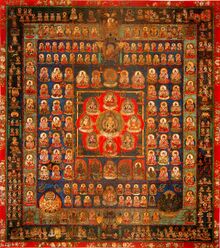
The womb realm. In Vajrayana Buddhism, the Womb Realm is the metaphysical space inhabited by the Wisdom Kings. The Womb Realm is based on the Mahavairocana Tantra, and is a central aspect of vajrayana practice.
In vajrayana, the Diamond Realm represents the unchanging cosmic principle of virochana, and final accomplishment, while the Womb Realm depicts the active, physical manifestation of virochana in the natural world. Here the buddha is not merely considered an external force, but is the process of your own spiritual development where once you enter nirvana you are in essence one with virochana.
Japanese Shingon and Tendai temples, in particular, often prominently display the Mandalas of the Two Realms mounted at right angles to the image platform on the central altar. The two mandalas are believed to have evolved separately in India, and were joined together for the first time in China, perhaps by Kūkai's teacher Hui-kuo.
In SMT nocturne, in the japanese intro it specifies more clearly than in the english one that the vortex world is meant to be the womb realm. This is also why it uses terms like conception. And so in-game it represents the archaic larval state of existence, and moving forward to a developed system. Although in the games, these two realms are not directly equated together. The vortex world's circular and inward focused design is likely also meant to call mandalas and their circular and inner focus to mind, and kagutsuchi taking the form of the sun alludes to him being a composite figure that includes virochana, who is associated with the sun.
The use of the womb realm represents the idea of spiritual development, and the beginning stages of it. But unlike in buddhism, here there is not just one destination, but it makes the existentialist point that you can develop in any direction. The womb realm and the process of cosmic egg are conflated since it shows how your perspective structures the world for you, and acting it out reflects and remakes the world in its image.
In loose connection with this, in smtv the cycle of the replacement of gods is known as the mandala system. Implying the cycle of reality in general being one which uses a lot of buddhist symbolism.
Metaphysics
Brahman is considered the ultimate panentheistic spiritual essence underlying and sustaining reality, and the world soul in hinduism. And in some sense was considered the only thing that on its own was absolutely “true.” It is beyond any attempt to comprehend, and in its most abstract form is sometimes presented as higher even than “God” in the sense of whatever they consider the highest sentient divinity. (This is true for most, but not all forms of hinduism. In some, the abstract brahman is itself an emanation.) But which was considered “the equivalent” to brahman.
However, even though it is higher than gods, who are higher than you, you have your own atman which is your own soul, which is considered in a sense equivalent to brahman in a microcosm / macrocosm way. And so once you are ultimately saved you will realize that you are brahman, and that brahman is you, and likewise your connection with all life because of this. (some forms of hinduism were dualistic instead of monistic, but obviously that is not what it was known for). People were seen as having individual souls that were a microcosm of brahman. Called atman.
Brahman is a close parallel to the great will in game, because all things are seen as part of it, and all gods seen as manifestations of parts of its qualities. Which is how they describe what they call "integrated monotheism" as the basis of the games. Even lucifer admits in some sense that he is a part of “God.” So he understands the underlying unity. But thinks that radical individualism can overcome this relation through the process of individuation. In persona 2, the demon virochana talks about atman and brahman as terms that relate brahman to the great will, and atman to the self.

Chakras. A chakra is an energy centre in the human body as taught in Indian yoga and some related cultures. Chakras are also believed in by some New Age adherents. Chakra means 'wheel' in Sanskrit. A chakra is an area in the body connected with life energy. There are seven chakras in the body - each is an interface for the flow of life energy. A chakra vitalizes a physical body and is associated with interactions of a physical or mental nature. In digital devil saga the areas in the junkyard are named after the chakras, giving a tone of the process as one of development.
The seven main chakras are described as being present in an ascending column from the base of the spine to the head. The chakras are usually connected with a certain color. Each chakra is also connected with some part of consciousness.
From lowest to highest they are:
1: Root chakra (Muladhara)
2: Navel chakra (Swadhisthana)
3: Solar plexus chakra (Manipura)
4: Heart chakra (Anahata)
5: Throat chakra (Vishuddha)
6: Third eye chakra (Ajna)
7: Crown chakra (Sahasrara)
Atman refers to your self in hinduism. While it doesn't have a single uniform understanding, one main aspect is that it is seen as a microcosm of brahman.
In Hindu philosophy, especially in the Vedanta school of Hinduism, Ātman is the first principle, the true self of an individual beyond identification with phenomena, the essence of an individual. In order to attain liberation (moksha), a human being must acquire self-knowledge (atma jnana), which is to realize that one's true self (Ātman) is identical with the transcendent self Brahman. It is seen as eternal and imperishable and beyond the ordinary effects of time. Though in a sense your normal atman can dissolve into brahman if enlightenment is achieved. This however is because it is often seen as having been like this all along, to be realized once illusion is taken away.
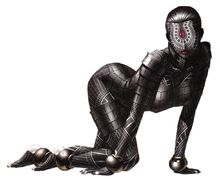
Maya, which you'll note is a boss from SJ working with the demons is “illusion.” Maya is the power of divinity in hinduism which creates the illusion of distinct entities within Brahman in order to let them have individual life. Since in most hinduism everything is one, but this preserves the distinction. It can be explained why it is seen as chaotic for that reason. Since this power of individuation can be tied to individuality, with maya in-game talking about how her power was what gave humanity the ability to live as individuals and sieze thier own destiny. Note that illusion is not a perfect translation. Since it does not mean that the result is false, but rather that it is true in a lesser way, and how this is is mysterious.
Sunyata, translated into English as emptiness and voidness, is a Buddhist concept which has multiple meanings depending on its doctrinal context. In Theravada Buddhism, Sunyata often refers to the not-self nature of the five aggregates of experience and the six sense spheres. Sunyata is also often used to refer to a meditative state or experience. In Mahayana, Sunyata refers to the precept that "all things are empty of intrinsic existence and nature". In Tibetan Buddhism, Sunyata refers to "openness and understanding nonexistence".
The importance of sunyata to buddhism is heavy. Sometimes even being treated like its ultimate, in place of a monotheistic god. Calling to mind negative theology. Empty is an insult in IV used by lucifer to describe the nature of god in a sense. Perhaps being meant to relate law to that aspect of buddhism. That could have an almost nietzschean interpretation too, since nietzsche said that monotheism in a sense represents man's desire for nothingness. Since the messian religion has a buddhist monk robe in it in Iv, that inspiration may be likely to be intentional. Doubly so since in nocturne, the assembly of nihilo has nihilo in its actual name and was that game's law equivalent. Setting some of the tone for future law figures, and referencing this buddhist aspect. Doubly so since in buddhism it is also sometimes used as a metaphor for a mind empty of impurities.
In strange journey, law figures often emphasize the phrase "this body" to refer to individuals. This ties to the idea of individuals not being truly discrete, but rather separate collections of properties. And sounds buddhist in tone. In iv, lucifer also calls merkabah empty in a way that adresses the ideological aspect of it. Sunyata also has an aspect which focuses on the nature of lack of substance in favor process, which is an aspect chaos likely draws from, albeit without seeing it as emptiness.
Anatman. In buddhism, anatman is the denial of soul or self. Buddha denied that such a thing as the self existed in any sense, (saying instead people were only bundles of properties) and said that likewise the world soul brahman didn't exist either. (these were related. Since the personal self was associated with the universal self denying one was denying the other). He likewise denied a highest god deriving from it. And so can explain why it is seen as swaying slightly towards chaos.
However, in mahayana, a thing similar to brahman was brought back called the Dharmakaya or Dharmadhatu or Truth body, being the universal essence of dharma and buddha, and all things. But was downplayed, and rarely referred to. but was considered an absolute ground as opposed to empty everyday phenomenon. It wasn't necessarily considered a world soul in the same sense. Though it was considered the thing everything comes from, and which buddhas "become." Note that anatman is denial of the existence of hindu atman.
The simile of the chariot is a buddhist metaphor that shows up in various versions in buddhist literature. It uses the idea of a chariot as a metaphor for the illusion of self. Many spiritual teachings use the idea of a chariot as a metaphor for the self, such as plato. And this ties to it being a one person vehicle you must steer around. But buddhism adds to this the idea that the self is an illusion. Saying that upon further scrutiny it is a collection of pieces with no fundamental lasting essence of "chariot" within it.
Mara in the games shows up riding a chariot in reference to this idea. In buddhism, the chariot is associated with the view of self, and so also is mara. Note that this provides an interesting inversion in that while buddhism depicts the self as a construct to be overcome, chaos' use of mara depicts it as something to embrace. Inverting the meaning of dharmic practice. A later version of this inversion shows up later in strange journey, where the hindu idea of maya or illusion is depicted as a positive thing, and tied to humans developing self awareness.
Skhandas. or Aggregates are what buddha posited you are in place of a concrete self. Basically, a bundle of shifting properties. Note that gabriel literally calls the white an aggregation of thoughts in IV. This even seems to imply that the demons and humans in some sense share the same aggregates, just arranged differently.
Note also that in buddhism, due to lacking a concrete self, your reincarnations are said to both be and not be identical to you. Since some of the properties are new, but some remain, bound by the stream of karma. Although reincarnations were generally seen to be 1:1, some teachings even said that all reality had buddha nature in it, even rocks. So the reincarnations might work in some more abstract way, with essence joining and being left. This applies to smt closely, since even reincarnations of single entities are seen as being somewhat distinct from them. Often in a way where they can accept or reject identifying with what they are a reincarnation of. Or even fusion and fission splitting the essence of individuals.
Dependent origination is the buddhist holistic idea in place of the hindu idea of everyone being connected through brahman. What it means is not that everything is one per say, but rather that the nature of causes means that distinct objects in general are illusions, since everything is one big network. One which in mahayana is even said to be lacking substance under it. People then are just streams of mind going through this. And they reach nirvana when they extinguish the stream. So note that in some cases ordered and chaotic seeming ideas can blend.
Impermanence refers to the focus on that all thigns are temporary and change. The gaian temple in I loosely talks about something that sounds like this.
The dharmakāya "truth body" or "reality body" is one of the three bodies (trikaya) of the Buddha in Mahayana Buddhism. Dharmakāya constitutes the unmanifested, "inconceivable" (acintya) aspect of a Buddha, out of which the essence of Buddhas arise (via buddha nature) and to which they return after their dissolution. Buddhas are manifestations of the dharmakāya called nirmanakaya ("transformation body"). It is the state one "goes" to in paranirvana although it is not a place, so much as an abstract pervading truth that underlies all reality. To distinguish it from the hindu idea of brahman, it was stressed that it was not an essence proper, sometimes defined as an indefinable underlying ground.
The dharmakaya though generally not considered an entity proper is sometimes treated as one under the name adibuddha. But it is stressed that this is not analogous to any particular entities as they exist in reality. Often using the explanation below.
One mind refers to a zen idea of referring to the dharmakaya that treats it almost like an inert world soul, albeit an acosmic instead of cosmic one. They desribe it by saying "All the Buddhas and all sentient beings are nothing but the One Mind, beside which nothing exists." This Mind, which is without beginning: is unborn and indestructible, has neither form nor appearance, and does not belong to the categories of things which exist or do not exist. The One Mind alone is the Buddha, and there is no distinction between the Buddha and sentient things, but that sentient beings are attached to forms and so seek externally (rather than internally) for Buddhahood. The One Mind alone is Buddha” says Huang Po. This is true. The real Buddha wasn’t necessarily the person who walked around 2500 years ago teaching us the Dharma – that form was merely a manifestation of the real Buddha.
Note that this doesn't mean that the buddha wasn't a distinct individual. But that as a buddha he was awakened to realization of himself as the buddha, of which there is only one. Note that describing it as lacking properties is ambiguous. Monotheistic religions often do the same for god. Note how these descriptions for the dharmakaya do not exist in original buddhism, and were a later development.
Since the idea of the one mind heavily influenced the later kyoto school ideas of jappanese philosophy, it is likely a large basis for how to understand the great will. Yhvh considers himself a manifestation of the great will in a similar sense to how buddhas are of the one mind and even looks like a buddha head potentially to represent this focus. It also relates to the focus of how one ultimately needs to seek inward which ties to atlus' focus on a humanistic understanding of religion. Because all things are part of the great will in a similar sense to how all things are said to equally be manifestations of the one mind. And the term great will even seems to come from the zen influenced kyoto school.
Goals and Practices
Hindu ethics. the basis for hindu ethics is often described as having to do with your relation to all life through brahman. Since other people are likewise brahman, like you, hurting them is seen as hurting yourself, in the same way smoking is hurting yourself down the line. How literally this was considered is up for grabs, but it is common throughout hinduism, even if it seems a little esoteric of a way to define ethics.
Note here that although gods sometimes told you how to be good or defined praying to them as a form of good, this form of ethics doesn't appeal to the gods to explain themselves. Merely to the interrelation of all life through brahman. Note that hindu and buddhist ethics are not phrased as imperatives, but more like virtues. Which though in practice this makes little difference, leads it to be seen in a more chaotic light. Nietzsche insisted that buddhism was beyond good and evil for this reason. Note of course that part of this is that at the times many of these things were being written down there often weren't words for morality as such. Only things like "virtue." Western philosophy and religion likewise reflects this ambiguity.
Hindu literature variously discuss ethics as one or more of four topics: (1) Gunas that is inner tendencies of conduct found in every individual (in large measure, psychology); (2) Purushartha that is proper aims of life for every individual for self-development and happiness (dharma, artha, kama and moksha); (3) Ashramas that is ethics for an individual in different periods of one's lifetime (ethical expectations for a child are distinguished from those for adults, old age); and (4) Varnasramas that is ethics and conduct for every individual in relation to society. Ancient literature at the foundation of various Hindu traditions primarily discuss the first three, while the last has attracted greater attention since the 18th century. Some early 20th century literature wondered if ethics was ever a major topic of study in Hinduism.
In strange journey, the reborn gore talks about how he has become all, and his consciousness is one with the planet. In keeping with the idea of a macrocosm microcosm type relation. One of the focuses being drawn here is that individual people are not wholly discrete, but part of the big picture, and it is a larger spiritual awakening to be able to tune into this, something captured in many mystical traditions.
The Noble Eightfold Path is an early summary of the path of Buddhist practices. The Eightfold Path consists of eight practices: right view, right resolve, right speech, right conduct, right livelihood, right effort, right mindfulness, and right "samadhi" (meditative absorption or union). The division is to help remember all the areas of life that issues could crop up in, and how they are balanced.
The wheel symbol of buddhism is often used to represent this, and is one of its main symbols. Right conduct focused on general things like killing and sexual misconduct. Note that the calls to do intense practice, and maintain peacefulness and serenity despite being a stereotype associated with buddhism as a whole were not rules regular buddhists were expected to do, but rules that applied to monks only. Different forms of buddhism do not all use the same ethics systems, but this is the most well known.
Saddha is the buddhist concept of faith. While buddhism does say that once you reach a high enough level of practice that you will know these truths for yourself, you are expected to take a provisionary level of faith in the teachings as you begin.
Ehipassiko is the buddhist concept of investigation. The contrast between saddha and ehipassiko relates to how ultimately in the end you will know the buddhist truths via direct insight, rather than mere faith, being called to test them for yourself.
Dharma is a key concept with multiple meanings in the Indian religions-Hinduism, Buddhism, Sikhism and Jainism. There is no single word translation for dharma in western languages. In Hinduism, dharma signifies behaviours that are considered to be in accord with ṛta, the order that makes life and universe possible, and includes duties, rights, laws, conduct, virtues and ‘‘right way of living’’. In Buddhism dharma means "cosmic law and order", but is also applied to the teachings of the Buddha.
In Buddhist philosophy, dhamma/dharma is also the term for "phenomena". Various games the word dharma is used for more or less its normal meaning. Maitreya mentions it in IVA, and shiva in digital devil saga 2. Note that in iva, maitreya describes it as individualist sounding, a personal thing you have to accept and work out on your own. Note that dharma is seen as relating to the dharmakaya described below.
Note that one aspect of buddhist enlightenment is lack of attachments. (that's an oversimplification, but you get the idea). The reason maitreya agrees with dagda in IVA about needing to not rely on people seems to be being interpreted as similar to the buddhist idea of non attachment, and likely personal reliance. Which is a little misleading, but in game it is used as that type of association. And is referred to as part of the dharma.
Maitreya's depiction is a little extreme, but a more viable interpretation is not to shun bonds on principle, but to enjoy them without necessarily absolutely needing them as part of your life so to speak. Which is closer to the buddhist interpretation. It comes off weird in game, but it makes sense why they would compare these. Note that another aspect of buddhism is that while buddhas are divinities, they cannot enlighten you for you, but you must do it yourself. So this idea of self reliance, and some independence is what maitreya's weird obsessive lines were about.
Dharma translates loosely to law or cosmic order. Obviously it is the order that following liberates you. And is a term in both religions. It is sometimes also used to refer to phenomena, tying the law of proper conduct to a universal law inherent in reality. Hinduism often distinguished the universal order from that proper for your station in life. Note that contrary to western belief, most historical buddhists and hindus were not seeking enlightenment, but merely a good rebirth. Enlightenment being seen as more the equivalent of Christian sainthood than just heaven. They would seek enlightement either in a far future rebirth, or depending on version perhaps not at all. Since in theravada, and some hinduism, not everyone would eventually be enlightened. In mahayana, it is said everyone would be, but not for trillions of years in the future. So for now one was merely seeking a good rebirth.

Liberation. hinduism, liberation is generally called moksha, and in buddhism it is called nirvana. Note that nirvana refers to enlightenment, whereas leaving the world system for good was paranirvana. An interesting thing about paranirvana is that its symbol is the laying down buddha, which you'll note is very similar to the pose that Mem Aleph is seen in, likely relating to how she gives up her form entirely.
Nirvana in buddhism relates to extinguishing the false sense of self that you have in everyday life. Called sunyata, or empty, to specify its illusory nature. The assembly of nihilo in nocturne being buddhist and lawful is somewhat tied to this idea, talking about focusing less on the sense of a distinct self, and so working in unison. Ahriman its sponsor being called the god of the void adds to this. Buddhism, especially mahayana often focuses on the empty nature of all things. But is not meant to be nihilistic, but in a sense anti nihilistic, saying that you must negate the idea that this emptiness negates value as well. Interestingly, in DDS2, jenna angel equates chaos with the term liberation, giving another dharmic slant to chaos. Saying that in chaos, those who excel can reach enlightenment.
in both hinduism and buddhism you can move up or down based on your karma. And even in a heaven your karma will run out sending you back to earth. So just getting to these heavens is not the final goal. In hinduism there's three or four ways to permanently leave samsara, some or all of which may or may not be taught in every form.
The first is being so moral that it breaks you free entirely. The second is being so devoted to god that your faith saves you. The third is knowing the relation between yourself and brahman so intensely that you realize you are one with it. A fourth one is sometimes added where your practice of mystic experience frees you. If you want, you can contrast these different paths by saying that the first two seem more law, and the knowledge relates to demons talking about knowledge, or mystical experience to something or other. But that's a tenuous connection.
In buddhism there is only one way to leave samsara. Leaving behind all of the things in it your mind clings to. However, in some sects, there were other options. Since doing it the “right” way was seen too hard for regular people, and something only monks could do, some more obscure buddhist groups tried to teach people various tantra that they said could be used as alternatives. In pure land variants you could however be saved by abodhisattva, who brings you to a heavenly pure land where you remain until liberation.
However, in both religions, it was assumed for regular people that enlightenment was not likely for you in this life. Even for monks it was seen as unlikely. Its more equivalent to christian sainthood. And the average person was simply hoping for a good rebirth. Their enlightenment may even be trillions of years into the future, since stays in heavens and hells were often tremendous periods of time. Note that deviating from or releasing yourself from the world system or universal order can be considered vaguely chaotic. Megaten games tend to focus on the lack of clinging aspect of nirvana rather than the serene focus, associating it more with chaos, who seek to accept the reality of endless change.
Note there's a distinction in your result. In hinduism, even after you realize you are brahman, in some forms you then simply exist in the highest heaven as still semi distinct entities. In others you dissolve into brahman and become one with it. In buddhism, once you leave samsara you become a kind of abstraction that is not an “entity” in the way you know of it, and described more by what its not than what it is. Lacking any contingency. Not only that, you are moving towards unity with brahman in hinduism. Whereas in buddhism, you are simply moving away from samsara. There was no identified thing that you were moving towards. Nirvana was not a thing, but simply the state you were then in.
The goal of ceasing to be born might of course seem too far from the goals of chaos to explain its buddhist associations. Chaos however interprets these Buddhist symbols not in a totally buddhist light, but as confirmed in interviews as a kind of revival of old animist polytheisms, but with buddhist elements. They take the goal of non clinging of nirvana and use it to construct an ideology of accepting the change of the world, even if it means your death. Though they interpret it in much more egoist of a light. Despite this, some chaotic figures still seem to actively seek dissolution.
While chaos figures also dissolve into the elements at times, tde is also depicted as an analogue of nirvana, since it involves an end being put to the rebirth of the world. Lucifer describes how life exists in a cycle of life and death, going through endless rebirths, but that ending the world permanently puts a stop to that. Since nocturne is a Buddhism focused game, this association here is meant to be explicit.
Note here that the games treat paranirvana as more simialr to a chaos goal of dissolving into the elements permanently, with your mind being nonlocalized. But also treats the goal of becoming one with a larger entity more lawful, even representing it as more orderly with krishna in iva. Dx2 shows that having virochana free you from rebirth is a goal some seek, so the idea of paranirvana is still one people seek in the games, even if not one that comes up often in mainline.
A distinction between theravada buddhism and mahayana is that in theravada the buddha leaves the world system for good on being enlightened. And yet he was able to stay if he wanted. Mahayana realized this was selfish sounding, and so posited a second goal of staying in samsara to help until those in it. The ones who did this were called Bodhisattvas. Some of them weren't even buddhas, only becoming one in the process of doing this. Pure land buddhism is one in which buddhas made their own heavens where people lived in peace until they could become enlightened, and the buddha of a pure land would bring them there.
Note also that its not a part of buddhism directly, that nietzsche was influenced by it indirectmy via schopenhauer, so that can also explain a relation. Even though chaos seems more indulgent, its focus on individuation and people choosing their own paradise obviously leaves open the room for some of them to consider individual ascetic practice this paradise. (Even though buddhism also points out that enlightenment is only likely to happen in humans, because hell beings, pretas, and asuras experience too much strife or disharmony, and devas experience close to no suffering and so can barely comprehend the idea of overcoming it. But obviously buddhism is not meant to be 1:1 to any side in game.)
In interviews, the makers said that Stephen, Mido (the one in the jaykou manor) and saint germain (likely also seraph) are characters who have freed themself from the cycle of birth and death in a sense by becoming immortal, relating this accomplishment to both hindu and buddhist ideas of doing so. Humans are in the center of the circle in these religions, and they state that in game that is likewise where humans appear. Though the connotations are a little different due to not having a direct pure good and evil metric. From this liberation, it is implied they now have a more direct understanding of and ability to interact with the great will. In the same interview they pointed out that leaving the cycle makes you a buddha in buddhism. Though here obviously the connotations are not meant to be identical to a buddha.
Note that stephen being the neutral representative may indicate that its something that reflects a type of demon one can become that is neutral aligned and retains a sense of one's humanity. And it reflects the fact that buddhas are seen as something that for the most part you will generally only be able to become when currently in human form. (Though note that in buddhism once you become a Buddha you are no longer human, similar to steven saying he transcended his humanity). And enlightenment in hinduism likewise is mainly in human form. Obviously part of this may be the fact that the games are not meant to have one set answer, and so the ambiguity of how to see it is deliberate. Note also however that post humans who transcended thier humanity are never called demons in game, other than those who are summoned,
Note that krishna in game also claims to be able to free people from rebirth. He talks about everyone becoming one, which resembles the hindu idea of people merging into god upon liberation. Likewise though, some separation is implied to exist however. Which can imply the other hindu idea of simply a highest heaven. The games don't really specify exactly what his world would entail completely. Note that religious ideas of afterlives are presented in game simply as alternate types of worlds. Not something inherently eternal. Meaning that being free from rebirth is likely not eternal either, but simply a state of some kind of immortality for the time.
Puja is the buddhist and hindu word for prayer. In buddhism, it is talked about in the Mangala sutta, talking about the veneration of holy beings being one of the highest blessed acts.
Meditation Although not particularly a form of ethics per say, as a practice meditation and other monk based practices were considered continuous with other Buddhist practices. Note that only a small segment of buddhists meditated in the past. Its popularity spreading is a modern phenomenon.
Tantra refers to the esoteric traditions of Hinduism and Buddhism that co-developed in the first century. It tends to denote a mystical focus on the microcosm and macrocosm, and focus more on intense ritualism than ideology. And has an association of self mastery, and becoming one's own master. It tends to be more affirming of strong feeling, saying that use of it rather than avoidance of it could also be used for spiritual development. Yab yum is a common tantric image, and many major chaotic demons are tantric in nature, giving chaos as a whole a recurring tantric association.

Malas are mantra beads used to recount mantras in buddhism, hinduism, and other eastern religions. (Even eastern orthodox christians have prayer ropes which seem loosely based on them). They generally have 108 beads, or numbers that are multiples or divisors of 2 to it. In game you often see gaians wearing them, such as kaga, or the enemy yami hoshi. But they are also worn by hikawa, (Who to be fair was a heretic member of gaia. Its unclear whether he considered himself a member or was only using them) and the messian magus seems to have mala inspired beads. But with a cross worked in as the prayer ropes tend to have.
Prayer wheels are whells full of prayers spun by buddhists, to increase praying effectiveness. In-game, anala drums seen in nocturne, and on the face of brahman are closely based on them.
Kama is a term in hinduism and buddhism that refers to sensual desires. This referring not merely to sexual desires, but all tangible things in the world that one has desire for. It is sometimes personified as an actual deity, but more often is used to denote the abstract concept. While kama is a thing seen as a facet of life in hinduism, it is also seen as at times dangerous. Stating that if dharma is ignored, kama leads to social chaos. Non tantric Buddhism uses the term in a more negative sense at times also, renouncing the desires that bind you to the world.
One distinction in tantric practice however is a different approach to kama. A fundamental theory of Tantric practice is that of transformation. Negative mental factors such as desire, hatred, greed, pride are not outright rejected as in non Tantric Buddhism, but are used as part of the path. A french indologist stated that tantric doctrine is "an attempt to place kama, desire, in every meaning of the word, in the service of liberation." In the hevajra sutra it states "By passion the world is bound, by passion too it is released." And "one knowing the nature of poison can dispel poison with poison."
What this means is that contrary to the forms of buddhism that emphasize upekkha and calm, tantric practices emphasize kama, and releasing and utilizing your passions. This is a large basis of the games in general, which seek to purpose spirituality for the benefit of human existence rather than opposed to it. Chaos delves into it even more deeply though, inthe sense that it is a large basis of chaos, since as stated in iva, one of the core doctrines of chaos is that they should unleash their suppressed emotions upon the world in order to shape it in accordance with their will. And its basis in tantra makes it an extreme version of that idea. Chaos strongly empasizes the keyword desire too, highlighting this concept.
According to Buddhist Tantra there is no strict separation of the profane or samsara and the sacred or nirvana,↵ rather they exist in a continuum. All individuals are seen as containing the seed of enlightenment within, which is covered over by defilements. Buddhahood is often not as something outside or an event in the future, but as immanently present and which your practice can manifest. And this aspect explains the more worldly focused aspect of all the sides in the games, though it also ties to chaos' upholding of the dark aspects of reality as nondualistically connected to the divine as well.
Symbols

Om. In Hinduism, Om is one of the most important spiritual symbols (pratima). It refers to Atman (soul, self within) and Brahman (ultimate reality, entirety of the universe, truth, divine, supreme spirit, cosmic principles, knowledge).The syllable is often found at the beginning and the end of chapters in the Vedas, the Upanishads, and other Hindu texts. It is a sacred spiritual incantation made before and during the recitation of spiritual texts, during puja and private prayers, in ceremonies of rites of passages (sanskara) such as weddings, and sometimes during meditative and spiritual activities such as Yoga. In SMT I the symbol of aum shows up on a banner in the gaian boss rooms at the end of the game. Implying in a sense that like law, they claim the abstract wold
soul for themselves.
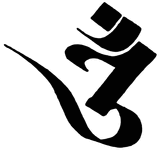
Hindus believe that as creation began, the divine, all-encompassing consciousness took the form of the first and original vibration manifesting as sound "OM". Before creation began it was "Shunyākāsha", the emptiness or the void. Shunyākāsha, meaning literally "no sky", is more than nothingness, because everything then existed in a latent state of potentiality. The vibration of "OM" symbolises the manifestation of God in form ("sāguna brahman"). "OM" is the reflection of the absolute reality, it is said to be "Adi Anadi", without beginning or the end and embracing all that exists. The mantra "OM" is the name of God, the vibration of the Supreme. When taken letter by letter, A-U-M represents the divine energy (Shakti) united in its three elementary aspects: Bhrahma Shakti (creation), Vishnu Shakti (preservation) and Shiva Shakti (liberation, and/or destruction). seed syllable form of it also shows up in tantric buddhism where it has a similar meaning of the unlimited, or the wholeness of reality. In SMTI, the gaians use the seed syllable om as a symbol on their banners in their main church and in the final areas. This is in keeping with their association with tantric buddhism. The seed syllables also show up associated with death skills, tying to the in-game association of them with dark and chaos.
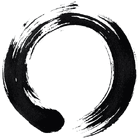
Enso is a symbol symbolizing emptiness, the universe, and enlightenment. It is common in japan. It is drawn in a single brush stroke, and considered a meditative practice to draw in and of itself.

The dharmachakra is an eight spoked wheel that represents the Buddhist eightfold path and Buddhism in general. Dharmachakra is literally translated as: wheel (chakra) of the Law (Dharma). In SMTII you see one being held by Atavaka, a demon who in buddhism used to be evil before meeting the buddha. Interestingly for II, both him and mara show up working under lucifer.

Vajra is a Sanskrit word meaning both thunderbolt and diamond. The vajra is the weapon of the Vedic rain and thunder-deity Indra, and is used symbolically by the dharma traditions of Buddhism, Jainism and Hinduism, often to represent firmness of spirit and spiritual power. When used as a symbol, sometimes two are overlaid facing different directions.
The vajra is the symbol of Vajrayana, one of the three major branches of Buddhism. Vajrayana is translated as "Thunderbolt Way" or "Diamond Way," and is the form of buddhism most associated with tantra. They are seen being held by various chaotic figures in-game, such as atavaka. Although they are also seen being held by demons on other sides.

The kila or phurba is a three-sided peg, stake, knife, or nail-like ritual implement traditionally associated with Indo-Tibetan Buddhism, Bön, and Indian Vedic traditions. This ritual dagger is associated with the meditational deity Vajrakīla. This knife is often used alongside other ritual elements such as the vajra or bell. And is often used for symbolic cuts, that can represent both meditational attributes as well as actual harm to befall one's enemies.

A Kartika is a small, crescent-shaped, hand-held ritual flaying knife used in the tantric ceremonies of Vajrayana Buddhism. The kartika is said to be "one of the quintessential attributes of the wrathful Tantric deities." It is commonly known as the "knife of the dakinis. The actual dakini in many of the games is seen holding both a kartika and a phurba. Although for the chaos side, the violent imagery is taken literally more often than in tantric buddhism, and it is taken in a post buddhist direction.

Kuji-kiri grid. The grid of kuji-kiri is a common esoteric symbol in shingon buddhism and shugendo that is visualized while chanting sacred syllables along with specific hand gestures that correspond to the lines on the grid. The grid is seen as symbol of of nine symbolic cuts through the illusion of the ordinary world that provides a basis for achieving enligtenment. Each cut has a special meaning, being power, energy, harmony, healing, intuition, awareness, dimension, creation, and the absolute. It is also commonly associated with ninjas or martial arts, due to the symbology of weaponry. In smt imagine it shows up as a symbol being used by chaos as one of their major symbols. Which is in keeping with their associations with shingon buddhism as well as martial arts.

Lotus. The lotus is one of the most well-known symbols of Buddhism and hinduism. The lotus flower is one of the "Eight Auspicious Symbols" in the religion, and is one of the most important images in the faith. The roots of a lotus flower extend into the mud and the stem grows up through the water and the flower blossoms above the surface. In Buddhist theought, this pattern of growth signifies the progress of the soul from the primeval mud of materialism, through the waters of experience, and into the bright sunshine of enlightenment. Though there are other water plants that bloom above the water, it is only the lotus which, owing to the strength of its stem, regularly rises eight to twelve inches above the surface. And so shows that despite being in a dubious place, the enlightened are untouched by anything.
In game, it shows up in digital devil saga II's last area, the game being based on hinduism, but it also shows up in small form with a cros on top in the corner of messian churches. Shesha's head in iva is also said to look like a lotus, and vishnu flynn is seen holding one.
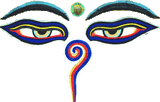
Buddha eyes. On virtually every stupa, which is a shrine of Buddhism, in Nepal, there are giant pairs of eyes staring out from the four sides of the main tower. These are Buddha Eyes (also known as Wisdom Eyes), and they look out in the four directions to symbolize the omniscience (all-seeing) of a Buddha. The Buddha eyes are so prevalent throughout the country that they have become a symbol of Nepal itself. In-game they show up on the backdrop of the fortune teller's place in SMTII.
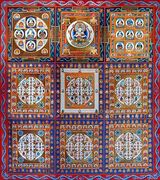
Mandala A mandala is a spiritual and ritual symbol in Indian religions, representing the universe. In common use, "mandala" has become a generic term for any diagram, chart or geometric pattern that represents the cosmos metaphysically or symbolically; a microcosm of the universe. The basic form of most mandalas is a square with four gates containing a circle with a center point. Each gate is in the general shape of a T. Mandalas often exhibit radial balance.
In game, the diamond realm mandala which vairochana is the center buddha of shows up in early intros, as does the location itself as an area. And later in IVA, matreya makes a seal on demons and teleportation he calls the tokugawa mandala, which when activated makes a mandala like shape over the city.
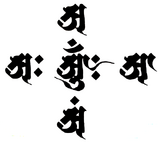
Seed syllables (Sanskrit bījākṣara) are considered to be the quintessence of mantra, and the ultimate condensation of the Dharma, each containing infinite meaning in a single syllable. Oṃ has held a special place in Indian religion since before Buddhism. Other seed syllables were elaborations of the first letter of a deity's name elaborated with the anusvāra and/or the visarga. In Buddhist tantra the Buddhas and Bodhisattvas are each associated with a seed syllable.
In megaten, the various seed syllables show up as adornments of death skills, and dark element skills in general. Which is a continuation of the association between dharmic religions, and the dark or chaos leaning that often shows up in the games.

Trident. Tridents are a common motif in various religions, such as being used by the gods poseidon and shiva, as well as being held by christian demons. In hinduism and buddhism, the trident is known as a trishula. In hinduism the three prongs refer to various triple aspects of reality, such as past, present, and future, or creation, maintenance and destruction. When held by shiva it is said to symbolize destruction of the three worlds, that of culture, the physical, and the mind, leaving only enlightenment.
In megaten, the chaos side has many tridents, both because of its dharmic association as well as its demonic association, with one being held by belial.

Tilaka. Krishna in iva has a U shape with a dot inside of it as his own symbol. This is known as a tilaka, and krishna in hindu artwork is often seen depicted with one like he has in game. (note this is a different symbol from the simple dot on forehead called bindi, despite also generally being used on a forehead, neck or hand). Note that krishna is a law leaning character, who like shijima is meant to bear similar ideological connotations without being called law in particular. He also has a lotus symbol on his belt, as well as holding one also. The tilaka is also used as a symbol by maya, one of the chaos mothers.

The third eye is a mystical and esoteric concept of a speculative invisible eye which provides spiritual perception beyond ordinary sight. In certain dharmic spiritual traditions. the third eye also refers to the ajna, or brow, chakra. The third eye refers to the gate that leads to inner realms and spaces of higher consciousness. While associated with dharmic religion, other eastern religions have equivalent though less common ideas, and it was later copted by theosophic groups. It shows up on many chaos figures as a symbol not just because of the many dharmic tantra chaotic figures, but also on mem aleph. However, it is not exclusively used by chaos, but also shows up as a symbol for various law figures as well, such as satan, shekinah, or ganesha.
Buddhist modernism
Buddhist modernism refers to one of any numer of new movements based on modern era reinterpretations of Buddhism. This can refer to secular buddhism, or other types of buddhism that have emerged in modern day that significantly change the purpose, many of which change the concept of paranirvana or drop it altogether. For instance, since secular buddhists do not believe in rebirth, by extension their practices are not undertaken for the goal of freeing you from it, but for upholding a specific frame of mind in the world. Chaos has a heavily buddhist tone, even using buddha statues in their temples, but this tone has a large aspect of buddhist modernism, because unlike traditional buddhists they do not necessarily see the highest goal as freeing yourself from rebirth, but rather living in a life affirming way and growing in power.
While many in the west in the past mistook buddhist modernism for a historical form of buddhism, the idea of secular buddhism is a wholly modern invention. Buddhism without gods or paranirvana is a modern invention, and largely a western one as well. Buddhism was adopted as an aesthetic by the west to mix with western romanticism in order to help assuage some of the spiritual crisis-es the west had undergone. One big aspect of this was to fight against the seeming mechanization and non-natural forms of living associated with western industrialism. Note that in the games, the more buddhist aesthetic chaos is depicted as more rustic and natural to contrast the futurist law, and its associated concerns.
Imperial way buddhism
Imperial way buddhism. Despite western stereotypes of buddhism as pacifistic, it does indeed have its own times it was used as a tool for violence similar to other religions. This is not to say that buddhism is inherently violent however. Just that like many things, it can be used as a tool for violence. Imperial way buddhism refers to the form of buddhism that was developed in the time leading up to world war II based on its heavy merging with nationalist and social darwinist attitudes. It justified steep social hierarchy via the doctrine of karma, justified militarism based on the need to expand buddhist influence, and used the concepts of serenity and non attachment to push the need to not challenge your role in the workings of the state. The figure of the emperor was turned into an icon of veneration who in many cases was seen as more central than that of the buddhas, as seen in the below quote:
>“All of Japanese Buddhism should have His Majesty, the emperor, as their central object of worship… The Buddhist statues that are enshrined in temples should, properly speaking, have the emperor reverently enshrined in the center and such figures as Buddha Amita or Mahavairocana at his sides. It is only the various branches of the Zen sect in Japan who have His Majesty enshrined in the center.” — Lt. Col. Sugimoto Goro (1900-1937) The book zen at war focuses on the history of Zen and Japanese militarism from the time of the Meiji Restoration through the World War II and the post-War period. It describes the influence of state policy on Buddhism in Japan, and particularly the influence of Zen on the military of the Empire of Japan. This being related to the fact that zen buddhism was considered by wartime japan to be a great inspiration and tool for militarism, moreso than shinto, and with most buddhist temples in japan supporting the war effort. Zen at war is considered perhaps the definitive title showing the connection between zen and japanese militarism. This form of radical nationalist and militarized buddhism has come to be known as imperial way buddhism, or imperial way zen.

As far as why this is relevant to megaten, wartime use of zen as a tool for violence appears to be a heavy inspiration for the chaos side. Gaianism in-game is both violent in tone, as well as heavily bearing a japanese buddhist aesthetic. And in addition to this, in SMTI there was a parallel drawn to world war II, with gotou being based on the real figure Yukio Mishima who sought to restore imperial japan. And the events in-game paralleled the end of world war II with the nukes dropped on japan. In keeping with how shinto was less radicalized as a tool for militarization, the neutral side in SMTI looks more shinto, and is more moderate.
During world war II, japanese wartime literature appealed to mahayana concepts of wrathful incarnations, and the idea that in situations of great seriousness one can be called on to kill so that others may live, saying that one must be sometimes accepting and sometimes forceful, and that they undertook the use of violence with the greatest seriousness. Many in japan considered the events to be a kind of holy war, with japan as on a holy mission of spreading its superior doctrines, and taking more area under the control of the emperor, who was seen as a divine force one owed fealty to.
The book points to various characteristics of buddhism that were drawn on to lead to support of the axis powers. One major one was the use of the idea of karma as a justification for inequality. People's place in what they saw as a natural hierarchy was seen as related to one's own effort, and so not inherently a problem. As such, the social darwinist ideas of the axis powers were seen as compatible with this view.
The emphasis on veneration of old and mature things. Since society was based "on a set of ancient and immutable laws", opposition to this was unacceptable. Upholding the culture, and preserving it by force against potential outside influences was seen as one's duty, and the emperor was seen as someone one owed a debt of gratitude to, and who was seen as like the head of the japanese family. The emperor was seen as in place based on being the head of a holy war, and the need to preserve their culture tied to serving him without question.
Another aspect was the close ties that zen practice had to the developed doctrine of bushido. At the point when japan was beginning to become militarized, budhiso was an easy thing to point at to discuss the continuity of the warrior class with the principles of zen, and to see them as special revered people. In practice, the higher up members of the zen hierarchy were heavily integrated with government, adding to the continuous line that gave rise to these associations. So much so that concepts like protection of the dharma were already worded similar to common phrases for protection of the realm.
The Buddhist logic of soku, "just as it is", which leads to "a static, aesthetic perspective, a detached, subjective harmony with things". This, in conjunction with buddhist ideas on inner peace were utilized to present this need for violence as just the way of the world, and hierarchy as a natural thing, one should seek to be serene in the face of, accepting its reality. The book says that Emphasis on inner peace, contributed to the failure to encourage and justify the will to reorganize society, something that was seen as not in tune with this serenity.
Emphasis on sunyata and selflessness was used to leave no room for the independence of the individual. It was treated as proper buddhist practice to downplay one's focus on the self in favor of subservience to the state. This was also tied to the belief in mutual dependency, which "led in modern Japan to an organic view of the state coupled with a feeling of intimacy towards it".
Obviously there are many ways this ties to the chaos side as depicted in-game. The idea of karma as a basis to defend hierarchy ties to the gaian emphasis on social darwinism, and the idea that people end up where they deserve to be. The emphasis on inner peace and acceptance of how things are related to how gaians not only accept this chaos as a fact of the world, but are encouraged even to accept their own death if they lose out. And gaianism also has a tone of calling back to the past, emphasizing ancient ways. Chaos even has a tone also of ingroup focus, and how one should work for those close to you.

Obviously this is not a perfect copy of chaos. It lacks the individualist tone that chaos sometimes has in later games. Although one should note that in SMTI chaos did not emphasize individualism as a main facet in the same way it did later on. The emphasis on sunyata also does not jive well with chaos' focus on your own will. Although note that some in chaos do seek to extinguish the self to become part of the power of the world in general, similar to the idea of nirvana. Note how in SMTI, the first gaian unit you see, called suicide unit is described as being willing to do anything under the orders of gotou, even going to their death, like japanese WWII kamikaze pilots. So even chaos sometimes has this tone of fighting for the interests of your own particular group even if it means self sacrifice.
Notably, in the gaian race there are units with named like “fallen monk” and “dark priest.” This accusation of these figures as being dark versions of buddhist figures seems to in and of itself being distancing this from normal peaceful practices. Saying that part of gaianism is resolving this tension between these militarized practices with the peaceful calls of buddhism by outright reinterpreting things in a more violent manner, accepting that it may be violating of what some of the precepts of peaceful interpretations originally were. Notably, buddhism is also associated with neutral a bit in SMTI, with the diamond realm being a neutral place, and so there is an element of gaianism acknowledging it is a dark version of these older traditions there. Obviously gaianism is in and of itself not buddhism, but a religion that grew from it, so this inversion is a notable way it would have distanced itself. As such, atlus is also trying to distance this darker militarized aspect from the main buddhist teachings.
Although this last point is a little unrelated, japan also had in its history a tradition of Sohei, or warrior monks. At certain points of history they held considerable power, obliging the imperial and military governments to collaborate. The prominence of the sōhei rose in parallel with the ascendancy of the Tendai school's influence between the 10th and 17th centuries. The warriors protected land and intimidated rival schools of Buddhism, becoming a significant factor in the spread of Buddhism and the development of different schools during the Kamakura period. So the tradition of buddhism and its ties to violence had been around for some time. Especially in a chaotic tone, when this violence was related to who would be a successor of certain monastic traditions. Although it was noted that a warrior monk seems like a contradiction even at the time.
